Fantasy Books
“The Ashtrays are Full and the Glasses are Empty” by Kirsten Mickelwait
The Ashtrays are Full and the Glasses are Empty is a star-studded novel based on…
The post “The Ashtrays are Full and the Glasses are Empty” by Kirsten Mickelwait appeared first on LitStack.
Tubi Dive, Part VI
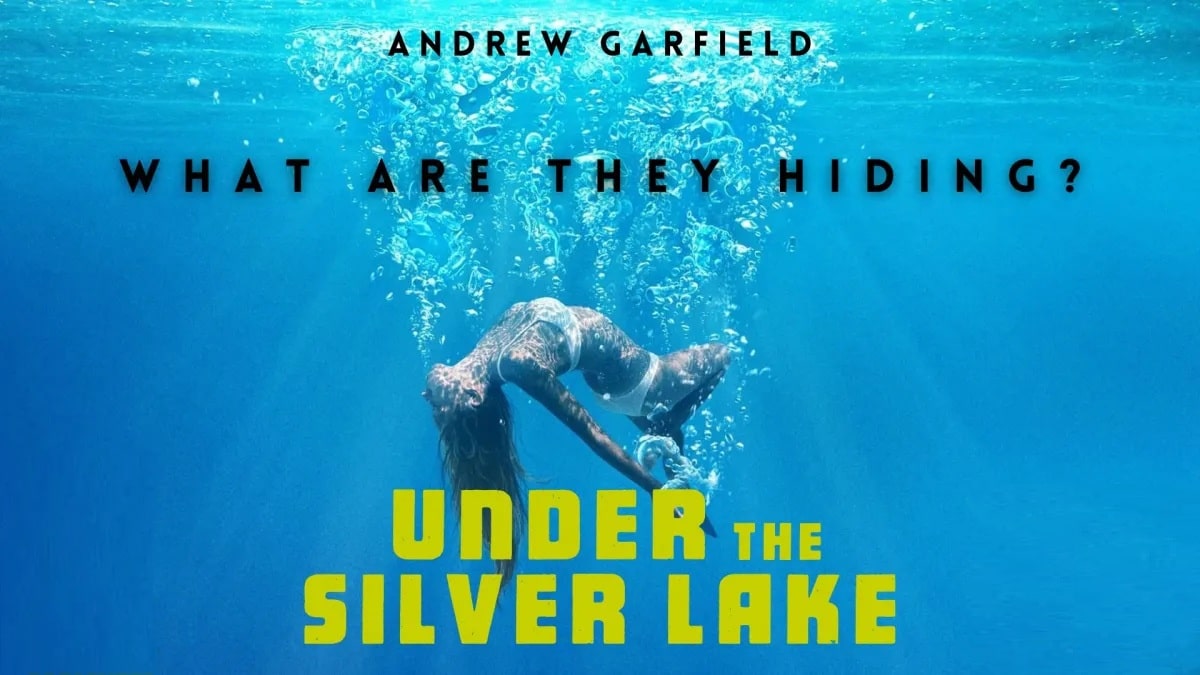 Under the Silver Lake (A24, April 19, 2019)
Under the Silver Lake (A24, April 19, 2019)
50 films that I dug up on Tubi.
Enjoy!
Under the Silver Lake (2018)Just in case you’re getting the wrong impression, Tubi isn’t all hidden schlock from around the world, there’s actually some proper* movies on there too.
Under the Silver Lake is the follow-up film from It Follows director David Robert Mitchell, and it seems the suits loved his horror film so much that they gave him free rein to do whatever he wanted to do.
What Mitchell wanted to do was make a two-hour, surreal, ‘slacker-noir’ type mystery film, with plenty of sex, violence, conspiracy theories and Andrew Garfield’s bottom.
I’m acutely aware that this is one of those films that sharply divides its audience. Some will bemoan the two hours they just lost on something they don’t understand, while others will wallow in its dreamlike narrative and unhinged tangents. I loved it.
Garfield plays a 30-something man who sits around doing nothing except smoke and watch his topless neighbour feed her parrots. When he falls for another neighbour his life is turned upside down, and leads him on a wild trail of hobo codes, murder, mysterious maps, secret codes, the truth behind pop culture, an urban legend, and a possible dog killer. Garfield is excellent as he drifts in and out of every scenario, looking increasingly worn down with each new revelation, and the supporting cast (mostly made up of attractive women there to feed his pervy addictions) are all great.
This was one of those films that drew me in and carried me along — I’ve seen comparisons to Mulholland Drive, but for me it felt like watching Mystery Train or Exotica for the first time.
Wonderful stuff.
10/10
*Proper to some. Everything I watch on there is proper.
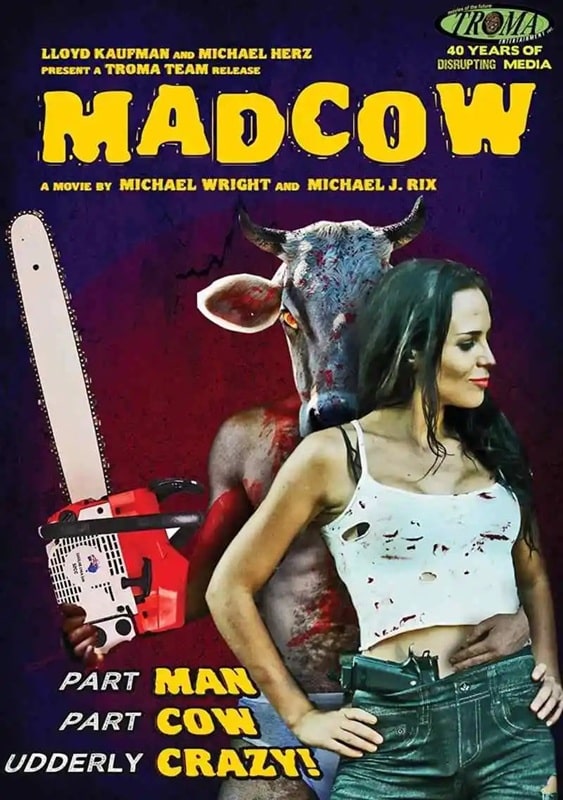
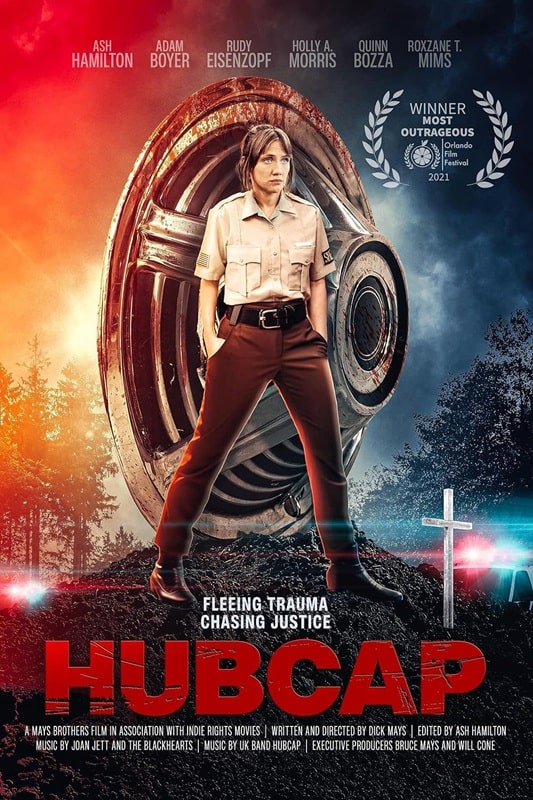
Mad Cow (Troma Entertainment, 2010) and Hubcap (Hubcap Film, 2021)
Watched a couple of sensible films recently, so I had to find a palate cleanser, and a Troma film usually does the trick.
Not strictly a Troma production (this was made by Funny How Films), Mad Cow was shot on a shoestring budget in 12 days (it shows), and is billed as more of a comedy than a horror film.
The story, for what it’s worth, concerns a scientist who transplants a cow’s head onto a human body. Said beastie then grabs a chainsaw and hilarity ensues. Actually, no it doesn’t. The deeply self-referential script is childish at best, deeply homophobic at worst, and I think I laughed twice at the Zucker Brothers-lite attempt at humor.
The funniest part might have been when I recognized most of the music as being stuff I had used myself for my student films, and when Kevin MacLeod’s name popped up in the end credits the film got a third titter out of me. So well done, I guess?
4/10
Hubcap (2021)Hoping for a spiritual successor to Quentin Dupieux’s Rubber (which I love), I settled down for this slice of road rage, and soon got, ahem, tired.
It’s a story of abusive relationships, PTSD, and political shenanigans, all tied together by a sentient hubcap possessed by the vengeful spirit of a war veteran.
What could have been highly silly, and somewhat enjoyable, becomes a bit of a slog from the midpoint once the main baddie has been dispatched and the hubcap stops its killing spree.
Oh well, plenty more fish* in the sea**.
4/10
* daft and gory films
** on Tubi
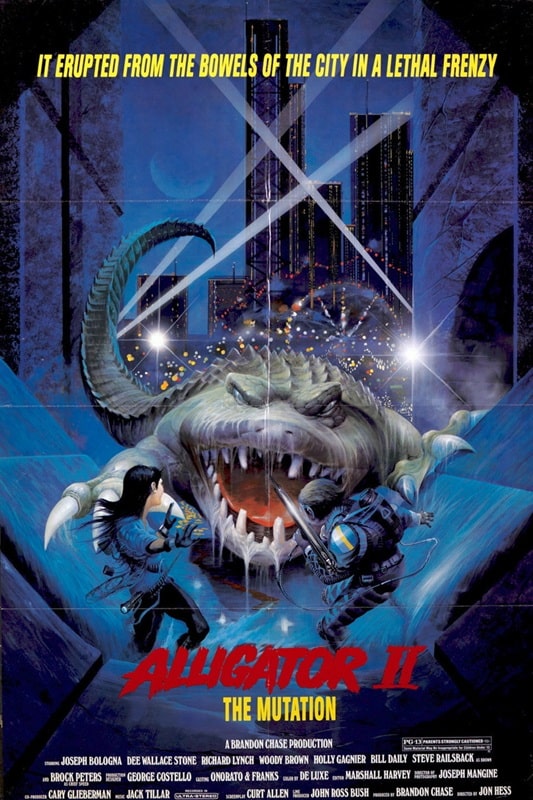

Alligator 2: The Mutation (New Line Cinema, June 5, 1991) and Vampire Clay (King Records, 2017)
Now then, I made a soft and slow rule that all the films I do these rubbish reviews for are first time watches, and yet I really think I’ve seen this one before. However, all I have is a sketchy memory of Richard Lynch in an underground alligator nest, so I can only assume that I caught a snippet one day on TV, or was very drunk at the time. Either way, here we are.
The first Alligator is awesome, but this one comes nowhere near to recapturing that magic. Instead we get another Jaws rehash with one-dimensional characters and dull kills. Joe Bologna is fine as the spiky detective who ain’t gonna follow the rules, but he’s no Robert Forster, and it’s fun to see Dee Wallace and Steve Railsback. The titular beastie is hardly a mutation though (just larger than normal).
They keep it light-hearted and there’s a couple of fun set pieces, but on the whole it’s a bit soggy.
5/10
Vampire Clay (2017)This is the feature-length debut of Sôichi Umezawa, who was responsible for the stop-motion insanity that was ‘Y’ in The ABCs of Death, so naturally I was quite excited.
The premise is great — a lump of clay is possessed by a disgruntled artist, which then goes on a blood-sucking spree when resurrected by an art student. The clay just needs moisture, any moisture, to reconstitute itself, and it dispatches art students and a hamster in a variety of slippery ways. Lurking in the background of this nuttiness is a commentary on modern art attitudes, a smattering of jealousy, and a dash of redemption, but we didn’t come here for drama and lectures. We came here for vampire clay.
Unfortunately, Umezawa is a way better short-form director, because this was unforgivably dull. The animatronic rubber and stop-mo effects were plentiful, but lit and shot so badly that they had no real impact, which was a pity. He does allow himself a gloopy animated sequence at the end (which really reminded me of a film I made about earwax a while ago), and the final clay creature is terrifyingly cute, but I was ultimately a little disappointed at what might have been. Oh well.
5/10
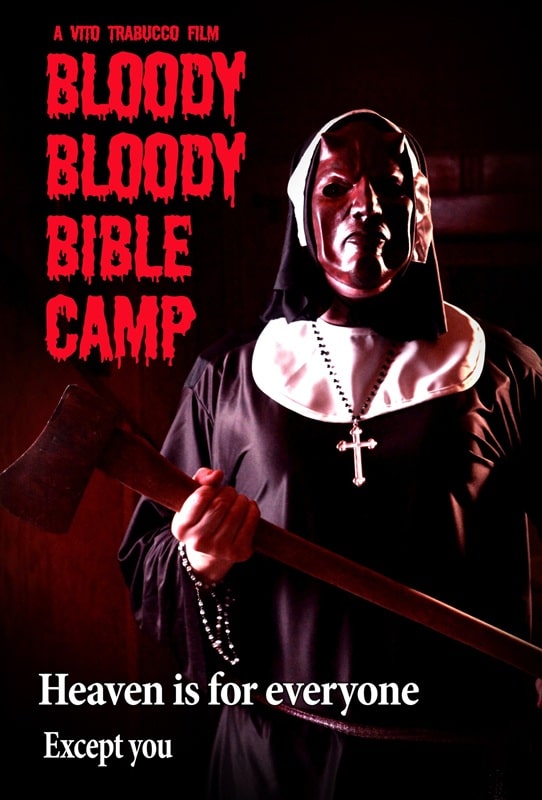
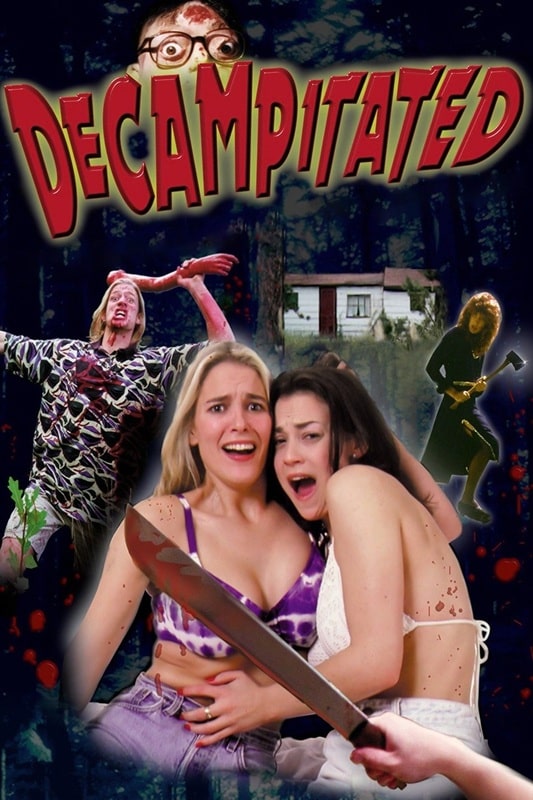
Bloody Bloody Bible Camp (Maltauro Entertainment, May 5, 2012) and
Decampitated (Troma Entertainment, 1998)
It’s 1977 (we know this because the characters are talking about Star Wars, Smokey and the Bandit, and the death of Elvis, all while sporting mustaches and/or short shorts), and the horniest bunch of Christians to ever walk God’s green earth are figuring out how to shag each other without upsetting the big man. Luckily, all this tediousness is put to a stop by a killer nun with a dagger crucifix.
Flash forward to 1984, and a new group of horny Christians are on their way to the same camp, led by ‘Father Cummings’, played by Phantasm‘s Reggie Bannister with some seriously dyed hair. As his name suggests, this isn’t as high-brow as you might expect (the mad nun’s name is Sister Chopper), and the filmmakers not only managed to adhere to the fodder-tropes for the characters, but also managed to make them hugely unlikeable.
There’s actually the germ of a decent slasher movie lost in here, but it is squandered in a maelstrom of unfunny dick jokes and a smorgasbord of hugely offensive moments, ranging from homophobic and transvestite ‘gags’, to anti-Semitism and sexual abuse. A shame really, as this has a fun (if a little hackneyed) premise. By the way, Ron Jeremy plays Jesus. JFC.
4/10
Decampitated (1998)Keeping with the campsite slasher theme, I decided to take a look at another Troma-backed effort, this one directed by Matt Cunningham. I thought I knew what I was in for after the excellent opening (but I was wrong).
The film starts with a woman fleeing for her life through the woods as she is pursued by a hunter wearing an apiary hood. She steps on a bear trap and saws her own foot off to hobble on her way. Then she steps on another trap and cuts the other foot off before dragging herself through the trees. Unfortunately, she puts her hand in a third trap and saws that off too. When her last limb is trapped, the hunter catches up to her and finishes her off. It’s absurd, mean and played for laughs, and I thought the tone would remain the same.
Sadly, the resulting film (unlikeable youths crash car, try to survive hunter) is so desperately unfunny, horribly shot (an over-reliance on fish-eye lenses) and horrendously over-acted in an effort to be ‘wacky’, that the whole thing soon becomes a chore. Plus, for the second film in a row, there is some major transvestite-bashing going on — what’s with these films? A smattering of fun, practical gore, but nothing to recommend.
4/10
Previous Murkey Movie surveys from Neil Baker include:
Tubi Dive, Part I
Tubi Dive, Part II
Tubi Dive, Part III
Tubi Dive, Part IV
Tubi Dive, Part V
What Possessed You?
Fan of the Cave Bear
There, Wolves
What a Croc
Prehistrionics
Jumping the Shark
Alien Overlords
Biggus Footus
I Like Big Bugs and I Cannot Lie
The Weird, Weird West
Warrior Women Watch-a-thon
Neil Baker’s last article for us was Part V of Tubi Dive. Neil spends his days watching dodgy movies, most of them terrible, in the hope that you might be inspired to watch them too. He is often asked why he doesn’t watch ‘proper’ films, and he honestly doesn’t have a good answer. He is an author, illustrator, teacher, and sculptor of turtle exhibits. (AprilMoonBooks.com).
Querying Writers: 14 Indispensable Resources For Success
For querying writers hoping to publish that first book, the challenge of querying for representation…
The post Querying Writers: 14 Indispensable Resources For Success appeared first on LitStack.
Virtual Sci-Fi/Fantasy Book Recommendations Event Video
If you missed the first quarterly Sci-Fi/Fantasy Book Recommendations event with the Ashland Public Library last night, you can catch the video on Youtube. This included discussion of the following books: The Changeling Sea by Patricia A. McKillip Warchild by Karin Lowachee The Raven Scholar by Antonia Hodgson The Jasad Heir by Sara Hashem Seed to Harvest by Octavia E. Butler These are quarterly half-hour long discussions taking place on Zoom on the third Thursday of the month, and the […]
The post Virtual Sci-Fi/Fantasy Book Recommendations Event Video first appeared on Fantasy Cafe.Tor Doubles #6: Barry B. Longyear’s Enemy Mine and John Kessel’s Another Orphan
 Cover for Enemy Mine by Maren
Cover for Enemy Mine by MarenCover for Another Orphan by Tom Kidd
The sixth Tor Double not only includes the two title stories, Barry B. Longyear’s Enemy Mine and John Kessel’s Another Orphan, but also includes an excerpt from Gwyneth Jones’s novel Divine Endurance. Divine Endurance was originally published in Britain in 1984 and in the U.S. as a hardcover by Arbor House in 1987. Tor was scheduled to publish a paperback edition of the novel in May of 1989, two months after this Tor Double hit the shelves. With the two title stories totaling only 158 pages, the decision was made to add a twenty page excerpt of the forthcoming novel.
Enemy Mine was originally published in Isaac Asimov’s Science Fiction Magazine in September, 1979. It won the Hugo Award and the Nebula Award, as well as the Locus poll. Enemy Mine kicked off Longyear’s “Dracon” series and was the basis for the 1985 film Enemy Mine, starring Dennis Quaid and Louis Gossett, Jr.
The year after the initial publication and success of Enemy Mine, Longyear published an extended version of the story, which has generally superseded the version that won the Hugo and Nebula Award. It is this revised version that is included in this volume.
Enemy Mine is set during a war between humans and the lizard-like Drac, both of whom see the other race as trying to impinge on their own nascent interstellar hegemonies. It is clear from the beginning that there is little communication between the races and the war has been taking place for quite some time and there is no end in sight.
When the novella begins, a human, Willis Davidge, and a Drac, Jeriba Shigan, have crashed on the planet Fyrine IV while a battle rages on in orbit above them. Seeing each other as alien and enemies, they continue in their attempts to kill each other, until they realize that the inhospitable nature of the planet means they have to work together in order to survive.
Over the course of a year, Jeriba and Davidge begin to understand each other and learn each other’s language. Jeriba taught Davidge about the Talman, the closest thing the Drac have to a religious text, as well as about their culture. The Drac are hermaphroditic and when Jeriba explains that it is expecting, the teaching opens up to the ancestor respect the Drac have for their hereditary line.
Had Longyear ended the story with the two enemies coming to terms with each other, and it is clear that Jeriba is more open to the idea of learning about humans than Davidge is with learning about the Drac, Enemy Mine would have been a typical science fiction story. However, the fact that Jeriba is expecting adds a twist to the story that elevates it.
When Jeriba dies in childbirth, it is up to Davidge to raise its child, Zammis, and protect it from the elements. Davidge does this to the best of his abilities, creating a person who is a mix of human and Drac philosophies and who loves the dangerous world upon which it was raised, even as Davidge continues to only see the dangers of Fyrine IV.
Eventually, rescue comes and Davidge finds himself back on an Earth following an armistice with the Drac. Trying to find work and living with his parents, he suffers the sort of disorientation many former soldiers find and is not fully able to fit into his society. When he realizes that despite the truce with the Drac, humans are still as prejudiced against the Drac as they had been during the war, Dravidge decides to attempt to rectify that by translating the Talman into English, although his primary goal is to earn enough money to travel to the Drac homeworld to see Zammis.
While Dravidge’s time with Jeriba and Zammis had taught him about the Drac and the philosophy espoused by the Talman, it gave him a very specific view of the Drac, specifically Jeriba’s own interpretation of Drac culture and philosophy. Upon his arrival at Draco, he learns that their society is every bit as complex and narrow minded as human society. His initial meeting with Jeriba’s father, Gothig, does not go at all as he expects and he learns that the Drac authorities can not be trusted to do the right thing.
Desptie the moment of truce following Dravidge’s rescue, it becomes clear that it is a temporary thing in Longyear’s world. The racial tensions and prejudices of the humans and Drac may be overcome on an individual basis, but they cannot be address on a societal level unless a new society, built apart from mainstream humanity or Drac culture, is allowed to be built.
Although Enemy Mine offers a roadmap to break the cycle of hatred, it does so with an understanding that it can only be done by disregarding the majority of people who may not be able to put aside the slights and atrocities, real or perceived, committed in the past.
I previously discussed Enemy Mine on September 3, 2019 as part of the “Golden Age of Science Fiction” series.
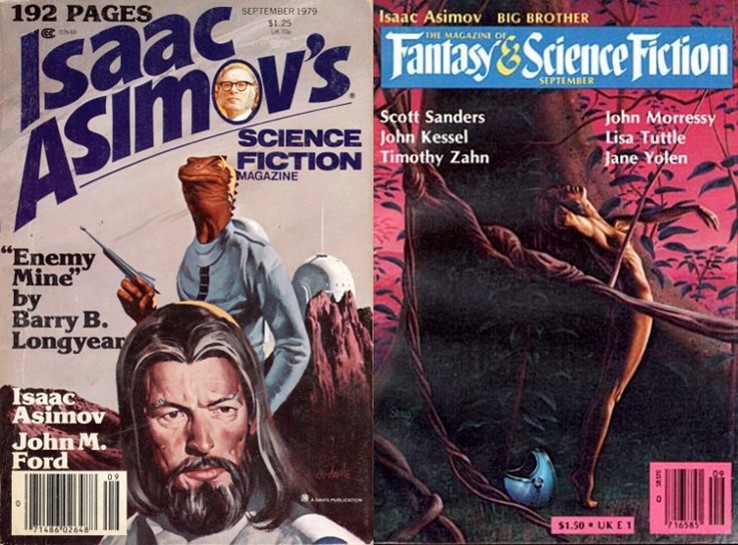 Isaac Asimov’s Science Fiction Magazine 9/79 cover by Vincent di Fate
Isaac Asimov’s Science Fiction Magazine 9/79 cover by Vincent di FateFantasy and Science Fiction 9/82 cover by Barclay Shaw
Another Orphan was originally published in F&SF in September, 1982. It was nominated for the Hugo Award and the Nebula Award, winning the latter.
Patrick Fallon has become unstuck in time, well, perhaps not, but there is a certain feel that he has given that he wakes up one morning and instead of finding himself working at the Chicago Mercantile Exchange he is on a sailing ship, with no memories of how he got there, but clear memories of his life in Chicago and his recent argument with his girlfriend, Carol.
However, Fallon belongs on the ship. The other sailors accept him and know his name. If they question his lack of knowledge of how do the he most basic tasks on the ship, they ignore their doubts, figuring he’ll work his way through it. And he does, with a small amount of help from shipmate Bulkington.
As he begins to figure out how to handle tasks, life on board the ships begins to gain a familiarity to Fallon, but not because he remembers life on the ship. Instead he begins to realize that he hasn’t slipped through time, but instead has slipped through realities, finding himself aboard the whaling ship Pequod, as described in Herman Melville’s Moby Dick.
Having read Moby Dick, Fallon knows that in the end the ship and its crew are doomed with the exception of Ishmael, who he can’t find among the crew. Although he entertains the idea that he may be fulfilling Ishmael’s role, Fallon decides he can’t rely on that hope for survival. After talking with Ahab and learning how much the captain is focused on killing his white whale, Fallon decides he needs to take matters into his own hands.
Fallon talks to other crewmen, including Starbuck, Stubbs, and Bulkington, trying to get them all to understand that Ahab’s focus threatens them all. While they may agree with Fallon, they also understand their place aboard the ship and can’t fathom the idea of mutiny, which is the only way to accomplish the action Fallon is calling for.
Even as he acclimatizes to life on board the Pequod, Fallon recalls his life in Chicago and yearns to return to the comfort and safety of life as a trader. His wife appears to be granted when he suddenly finds himself back in Chicago, preparing for a day of work, and finding that he is as lost there as he was when he first awoke on the Pequod. However, His two lives bleed into each other and Fallon realizes that whether he is in Chicago or the Pequod, the crew he has been living with are moving toward the inexorable climax of the novel which seemingly means Fallon’s death as well as the rest of the crew, with the exception of the enigmatic and undiscovered Ishmael.
Kessel appears to be having fun torturing his main character and the reader by showing them the parallels between the Pequod of Moby Dick and the Pequod of Another Orphan. Because the novel was written by Melville 130 years before Kessel’s story, the events of the story would seem to be set, but Kessel subverts that with the ideas, put forth by both Fallon and Ahab, that events can be fluid and are not predestined. While Fallon is hopeful that the destiny he sees can be averted, Ahab sees an outcome that involves the death of Moby Dick, but doesn’t necessarily mean the destruction of his ship or crew, and until that occurs, the results are undecided.
Fallon’s story is not neatly wrapped up. The final encounter with the whale is still in his future and Ahab is still his captain. Their future has not yet been written, but Kessel leaves them with a sense of dread that they won’t be able to avert the ending Melville has written for them and Fallon may never be able to turn his back on the Pequod and return to his life in Chicgao.
The cover for Another Orphan was painted by Tom Kidd. The cover for Enemy Mine was painted by Maren.
 Steven H Silver is a twenty-one-time Hugo Award nominee and was the publisher of the Hugo-nominated fanzine Argentus as well as the editor and publisher of ISFiC Press for eight years. He has also edited books for DAW, NESFA Press, and ZNB. His most recent anthology is Alternate Peace and his novel After Hastings was published in 2020. Steven has chaired the first Midwest Construction, Windycon three times, and the SFWA Nebula Conference numerous times. He was programming chair for Chicon 2000 and Vice Chair of Chicon 7.
Steven H Silver is a twenty-one-time Hugo Award nominee and was the publisher of the Hugo-nominated fanzine Argentus as well as the editor and publisher of ISFiC Press for eight years. He has also edited books for DAW, NESFA Press, and ZNB. His most recent anthology is Alternate Peace and his novel After Hastings was published in 2020. Steven has chaired the first Midwest Construction, Windycon three times, and the SFWA Nebula Conference numerous times. He was programming chair for Chicon 2000 and Vice Chair of Chicon 7.
Goth Chick News: Oh Deer – Bambi Goes Berserk in The Reckoning
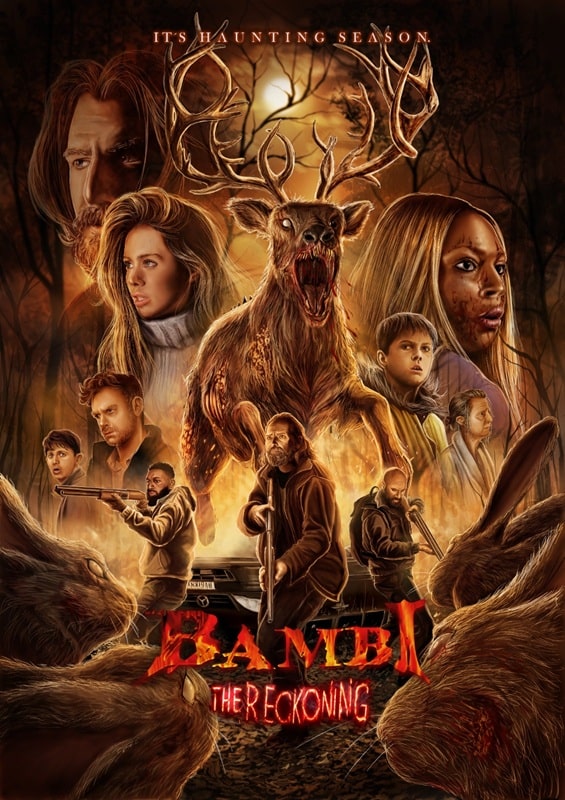 Bambi: The Reckoning (ITN Studio, July 25, 2025)
Bambi: The Reckoning (ITN Studio, July 25, 2025)
File this one in the “Why the F?” folder.
Bambi: The Reckoning is a British indie horror flick directed by Dan Allen and written by Rhys Warrington. It marks the fourth disturbing entry in The Twisted Childhood Universe (TCU), which brought us Winnie-the-Pooh: Blood and Honey and is now turning Felix Salten’s beloved deer into a forest-dwelling force of vengeance.
The Brits must really hate us.
Starring Roxanne McKee, Tom Mulheron, Nicola Wright, Samira Mighty, Alex Cooke, and Russell Geoffrey Banks, The Reckoning twists the tale of Bambi into a blood-soaked revenge story. The premise? A grieving, mutated Bambi — yes, you read that right — goes on a rampage after his mother’s untimely demise, targeting a hapless mother and son caught in his antlered crosshairs.
Though I’m not suggesting you do it, here’s the trailer if you want a look.
The project was first teased back in November 2022, when Bambi: The Reckoning was announced as the latest horror romp to traumatize a generation raised on wholesome animated classics. Helmed by Jagged Edge Productions, the film takes inspiration from the eerie creature design in Netflix’s The Ritual, because apparently, we all needed Bambi to double as nightmare fuel. Producer Scott Jeffrey described the flick as “an incredibly dark retelling” of Salten’s 1928 book, with our once-gentle deer transformed into a “vicious killing machine that lurks in the wilderness.”
Production kicked off in London on January 6, 2024, and filming wrapped just twenty days later — let me show you my shocked face.
Bambi: The Reckoning is set to hit U.S. theaters on July 25, 2025, so mark your calendars and prepare to binge-watch the Disney Channel that day instead.
Spotlight on “Ecstasy” by Ivy Pochoda
Ecstasy is a deliciously dark horror reimagining of a Greek tragedy, by Ivy Pochoda, and…
The post Spotlight on “Ecstasy” by Ivy Pochoda appeared first on LitStack.
Review: Level: Ascension by David Dalglish

Buy Level: AscensionRead our review of Book 1, Level: Unknown
FORMAT/INFO: Level: Ascension was published by Orbit Books on May 13th, 2025. It is 400 pages long and available in ebook, audiobook, and paperback formats.
OVERVIEW/ANALYSIS: In order to save his world, Nick will have to end another. With a large black disc traveling closer and closer to his research station, Nick spends nearly all his time in the fantasy world of Yensere, a digital simulation created by a mysterious alien artifact. In Yensere, the god-king Vaan has frozen a similar looking black sun in the sky; this has prevented an apocalypse in Yensere but disrupted the patterns of time and nature in a way that seems to be destroying the world anyway, if more slowly. If Nick is to understand the doom that approaches his people, he will have to kill the god-king Vaan and unleash disaster on Yensere so that he can gain whatever knowledge he can. But before then, he'll have to defeat the god-king's chosen champions - a task that will come with a devastating cost.
Level:Ascension continues to expand its world in interesting ways, but the plot was overwhelmed by the sheer number of fight sequences. On the plus side we get to learn more about Frost, her origin, and how her sister went missing. It added some much needed personal stakes to the story beyond the also important "save the world." I also appreciated the teases we get indicating that Yensere isn't the only digital world contained within the alien artifact.
But these small nuggets of clues and character insight were overwhelmed by fight after fight after fight. On the one hand, I understand that a LitRPG is going to have a lot of battles in it, especially when it's inspired by a game like Dark Souls. Going from one epic fight to another is literally what that game genre is all about. But the more fights you have with everyone wielding awe-inspiring powers, the less exciting each encounter feels.
Don't get me wrong, in a vacuum the individual fights are impressive. As always, this author delivers a powerhouse finale that is a great set piece with personal stakes. But I could have used one or two fewer fights and a little more time expanding on some of the other characters. Sir Gareth, for instance, was a strong part of book one, but gets a bit left by the wayside in this sequel, a hazard of several new characters entering the playing field.
CONCLUSION: For some of you, hearing that Level: Ascension is chock full of impressive fight scenes is going to be fantastic news, and I encourage you to go give this series a try! For me, while I enjoy the overall concept of this simulated world, I had a bit of trouble finding the momentum in this particular outing. Perhaps with everything coming to a head in upcoming Level: Apocalypse, I'll find that momentum once more.
Writ in Water: V.E. Schwab’s The Invisible Life of Addie LaRue
How many times have you heard (or even repeated) the old adage, “Be careful what you wish for?” Of course it’s a cliché, a commonplace beloved of parents and primary school teachers the world over, but such chestnuts sometimes actually contain the distilled wisdom of the human race, and you ignore them at your peril, as is demonstrated (or not, maybe) in Victoria Elizabeth Schwab’s 2020 dark fantasy, The Invisible Life of Addie LaRue. It’s a spirited, stimulating read that gives you something to think about.
The story begins in a small French Village, Villon-sur-Sarthe, on a summer evening in 1714. A young woman named Addie LaRue is “running for her life.” Her family has affianced her to an inoffensive but crushingly dull young man. Addie, however, doesn’t want her life to be yet one more colorless copy of the bland existence that her mother (and her mother before her, and her mother before her, and her mother before her…) has led.
Addie has occasionally gone with her carpenter father (who she is closer to than she is to her unsympathetic mother) on business trips to a neighboring town, and these all-too-rare glimpses of the world outside have sparked something in the young woman. She wants to see Paris, she wants to see the world, she wants to go where she will and love who she will. Looking around the well-known, changeless streets of her home, they look more and more like the bars of a prison; she knows that’s not what she wants. She knows she wants more.
Addie’s dreams and ambitions have been (somewhat equivocally) encouraged by an old woman of the village, Estelle Magritte, who is considered by some to be a witch. Estelle talks to Addie about the ancient, elemental, unpredictable gods of the fields and the forest, but she gives the girl one piece of very serious advice:
The old gods may be great, but they are neither kind nor merciful. They are fickle, unsteady as moonlight on water, or shadows in a storm. If you insist on calling them, take heed: be careful what you ask for, be willing to pay the price. And no matter how desperate or dire, never pray to the gods that answer after dark.
It’s counsel that Addie might have been better off heeding.
Fleeing her wedding, Addie plunges into the woods; as she goes deeper into them, the voices of her pursuing family grow fainter and fainter until they disappear. Addie falls to the ground, exhausted, and desperately begins to pray to the only source of help that she can think of, the old gods that Estelle has told her about, but more time has passed than she thinks; she doesn’t realize that the sun has set and that she is calling into the darkness.
Her plea is answered by one of the capricious, compassionless gods that Estelle warned her against, and though he may be inhuman, he at least has an ironic sense of humor, as he comes in the form of the fantasy lover that the lonely Addie “has conjured up a thousand times, in pencil and charcoal and dream.”
 Congratulations — you are now the proud owner of a Ford Fiesta! All it will cost you is your soul!
Congratulations — you are now the proud owner of a Ford Fiesta! All it will cost you is your soul!
After the being asks if she is prepared to pay the price for his services, Addie makes the fatal promise, “I will pay anything.” The entity, be it god, devil, or something so entirely other that it cannot fit into either of those common categories, asks her why she is willing to do this. The girl replies with what amounts to her manifesto:
“I do not want to belong to someone else,” she says with sudden vehemence. The words are a door flung wide, and now the rest pour out of her. “I do not want to belong to anyone but myself. I want to be free. Free to live, and to find my own way, to love, or to be alone, but at least it is my choice, and I am so tired of not having choices, so scared of the years rushing past beneath my feet. I do not want to die as I’ve lived, which is no life at all. I –”
The being (which she will soon name Luc) cuts her short. He’s not interested in what she doesn’t want. Can she tell him what it is that that she does desire? That’s easy; Addie wants more time. Luc puts the wish into words for her — “You ask for time without limit. You want freedom without rule. You want to be untethered. You want to live exactly as you please.”
“Yes,” Addie says… but Luc declines the deal. After all, what’s in it for him? He gives her life unending, and he gets nothing? It’s hardly fair. And in that moment, Addie hears again the voices of her family and the other villagers, searching for her, growing louder, coming closer. And in that last moment, she recklessly stakes everything. “You want an ending,” she says. “Then take my life when I am done with it. You can have my soul when I don’t want it anymore.”
Deal.
The rest of the book shows us what kind of life Addie has purchased, and it does so with a forward/backward structure that alternates chapters showing that life in the eighteenth, nineteenth, and twentieth centuries (she spends most of the early eighteenth-century chapters discovering exactly what sort of covenant she has entered into), and chapters set in New York City in 2014.
What is the nature of the bargain Addie has made? (Of course, Luc’s deal comes with small print — there’s always small print.) As is common in such transactions, it soon becomes clear that Luc has given her exactly what she asked for. She wanted complete freedom, a radically unfettered life; she wanted no obligations to anyone, and her “benefactor” has found the perfect way to grant her wish.
Addie is free to go where she will, free to do what she wants, free to spend her time in the company of whomever she pleases, and people are drawn to the beautiful, bewitching young woman with the constellation-like pattern of seven freckles on her face. They love her when they’re with her. But when she leaves the room for more than a few minutes, or when they do, or when they fall asleep…
They completely forget her; she vanishes from their minds and memories as thoroughly as if she had never existed. In an especially painful twist, people are unable to even speak her real name.
As the years pass and Addie travels far and wide, she leaves her narrowly circumscribed life in her stultifying little village far behind, and she indeed sees the world — but the cruel nature of her bargain makes it impossible for the world to see her. She finds herself living a rootless, utterly transitory existence which is, in the words of John Keats’ pathetic epitaph, “writ in water.”
Through all these restless centuries, Addie lives by theft (which bothers her, but what else can she do), finds temporarily vacant houses or apartments to stay in for a day or a week, and establishes relationships as transitory as the lives of mayflies. For the first few decades, Luc appears every year to see if Addie is ready to surrender her soul. She always refuses, even as she finds herself looking forward to these visits — who else can she have a real conversation with? Luc’s visits eventually become much more sporadic (despite the hints of a growing and ambiguous attraction between the two, especially on Luc’s part; perhaps it is not good for even a god to be alone). Neither the human nor the inhuman are in a hurry; after all, they both have nothing but time.
Even in the midst of her exile, Addie takes heart from knowing that she has managed to leave some subterranean traces in the world after all, in the works of artists she has briefly known. Luc has been unable to prevent a ghostly record of Addie from appearing in a painting here, or in a song there. This helps her to hang on despite her unassuageable weariness. (That, and she’s just damned stubborn.)
The story makes a major shift in the second half of the book, when, in present-day New York, Addie meets a young man named Henry who works in a used bookstore. He is the one Addie has been waiting hundreds of years for; miraculously, he can remember her. (Addie discovers this when she tries to steal a book.)
Addie and Henry quickly fall in love, or at least, Addie sees that as a real possibility. (For her, he’s the only game in town.) But why is he different? Why can he remember her? The answer turns out to be simple — he, too, has made a deal, and is therefore living outside the boundaries of normal human existence.
Henry’s dilemma was the opposite of Addie’s — the youngest son of a prosperous, successful family, he always felt overlooked, ignored, invisible. No one ever saw him for who he really was. When he proposes to a young woman he has fallen in love with, she turns him down, making it clear that he’s nice and all that, but ultimately he’s not all that important to her. Shattered, Henry decides to commit suicide, but before he can complete the act, Luc appears with an offer: instead of being a person people see through, Henry will become a man no one can miss. Whenever anyone looks at him, they will see whatever they most desire. To everyone he meets, he will be the most important person in the world.
You see the problem, don’t you? Henry, of course, doesn’t, and he accepts the deal.
Now when people look at him, speak to him, have sex with him with glaze-eyed delight, they’re not really seeing him at all; they’re seeing an embodied fantasy that has nothing at all to do with the actual Henry Strauss, and the young man ultimately finds himself more even isolated and desolate than he was before.
This why Henry can remember the ephemeral Addie and why Addie can see the actual Henry — the bargains that they struck perfectly complement each other; their hells dovetail seamlessly.
One difference, though, is that Henry didn’t drive a very hard bargain; his contract isn’t open-ended, and when he meets Addie, the bill is about to come due. Henry has just over a month to live.
A few days before Henry is to die, Luc appears to Addie for the first time in thirty years. Does he know that he finally has her where he wants her? Maybe so, because Addie then finds out the terms of Henry’s contract, and having at last found someone she can willingly sacrifice herself for, she proposes a new bargain: she asks Luc to give Henry (who is “the one piece of her story that she can save”) his life back.
If Luc does this for her, Addie tells him, “I will be yours, as long as you want me by your side.”
Done.
The story ends two years later with Addie browsing in a London bookstore. She hears a customer ask for a copy of a hot new novel that’s making quite a stir. Written by an anonymous author, it is titled The Invisible Life of Addie LaRue.
Finding a copy herself, Addie tremblingly looks at the dedication page; it bears just three words: I Remember You.
Addie knows then that she has won her gamble, and when Luc appears and they walk out of the bookstore together, she thinks that the god who seemingly brought her to bay has been too clever by half. She has an unlimited amount of time in front of her, all the time in the world, time enough to work on Luc as he worked on her, time to “ruin him,” to “break his heart,” to “drive him mad, drive him away.” All the time there is, to make him willingly “cast her off.”
Then, and only then, Addie LaRue will have what she desperately desired so long ago. Finally, she will be free.
The Invisible Life of Addie LaRue is an engaging and highly imaginative book, but I do have a couple of quibbles. Addie’s discontent and (especially) the way she thinks about it and acts on it seem more like that of someone born at the end of the twentieth century than of someone born at the end of the seventeenth. Truly entering into the thought-world of a person of such a radically different era is a difficult task (perhaps especially so in our highly “presentist” age) and I can’t say that Schwab has entirely pulled it off. (I also think that kind of portrait wasn’t something she was really aiming at.)
Also, I was less than enthralled with the second half of the book’s “current-day” sections, which largely became one long episode of Young Brooklyn Romance, which, if it isn’t a hit new Netflix series, probably soon will be. In any case, it’s not the sort of thing that winds up at the top of my watch list. With the entrance of Henry, the book moves from things I’m more interested in (explorations of what freedom is and what it’s for, and of the relationship between community and identity — to what extent do we even exist except in relation to other people?) to something I’m less interested in (urban love among the achingly trendy). I say this understanding that I’m not a part of the target demographic of either the novel or the hypothetical show — and by the way, if anyone uses my title, they had better pay me.
Those complaints aside, the story Schwab tells is consistently engaging and entertaining, and at times even thought-provoking. The Invisible Life of Addie LaRue gains much of its power from being a lively new variant on a very old tale and by maintaining its connection with countless myths and stories that have gone before; the novel contains echoes of Faust, The Picture of Dorian Gray, The Wandering Jew, The Flying Dutchman, The Devil and Daniel Webster, and Peter Pan, to name just a few, and Addie can stand unembarrassed in their august company.
Two more recent stories that Addie LaRue also reminded me of are Lolly Willowes, Sylvia Townsend Warner’s 1926 novel of a woman who becomes a witch and sells her soul to the Devil in order to do exactly what Addie wanted — live her own life. Warner was a major writer in many different modes and Lolly Willowes is a masterpiece of double-edged irony, but even though Schwab’s book operates on a less profound level than Warner’s, it’s still not a stretch to speak of them both in the same breath.
Also, Luc strikes me as being at least a cousin of that malevolent aristocrat of Faerie, the Gentleman with the Thistle-Down Hair of Susanna Clarke’s wonderful Jonathan Strange and Mr. Norrell, though the Gentleman is frightening in ways that Luc can’t begin to match. (No person in their right mind would contemplate for an instant having a relationship, romantic or otherwise, with the Gentleman.)
Reading The Invisible Life of Addie LaRue and thinking about the questions it raises brought to mind something that Carl Jung, the founder of analytical psychology, once wrote:
People do not realize just how much they are putting at risk when they don’t accept what life presents them with, the questions and tasks that life sets them. When they resolve to spare themselves the pain and suffering, they owe a debt to their nature. In so doing, they refuse to pay life’s dues and for this very reason, life then often leads them astray. If we don’t accept our own destiny, a different kind of suffering takes its place… One cannot do more than live what one really is. And we are all made up of opposites and conflicting tendencies. After much reflection, I have come to the conclusion that it is better to live what one really is and accept the difficulties that arise as a result — because avoidance is much worse.
Addie challenges the status quo and pushes the boundaries of freedom and in doing so, she gets more than she bargained for… or does she? In making her initial deal, is she avoiding her destiny or accepting it? It’s possible to come down on either side of the question. It wouldn’t surprise me if one of these days, Schwab writes a sequel that gives us a more definitive answer.
I’ll definitely be there for it… but the world is wide and there’s no limit to places you can set a book, so can we stay out of Brooklyn? Please? I’d give almost anything…
 Abandon all hope, ye who enter here
Abandon all hope, ye who enter here
Thomas Parker is a native Southern Californian and a lifelong science fiction, fantasy, and mystery fan. When not corrupting the next generation as a fourth grade teacher, he collects Roger Corman movies, Silver Age comic books, Ace doubles, and despairing looks from his wife. His last article for us was Life Lessons from David Cronenberg
7 Author Shoutouts | Authors We Love To Recommend
Here are 7 Author Shoutouts for this week. Find your favorite author or discover an…
The post 7 Author Shoutouts | Authors We Love To Recommend appeared first on LitStack.
Book review: Someone you Can Build a Nest in by John Wiswell

Book links: Amazon, Goodreads
ABOUT THE AUTHOR:
Publisher: Length: Formats:
Someone You Can Build a Nest In is a monster romance. The main character, Shesheshen, is a shapeshifting creature able to build herself out of bones and organs of her victims. Yes, she eats people, but she is also trying to figure out love.
The story starts with Shesheshen getting chased out of her swamp by hunters and falling off a cliff. She’s rescued by Homily, a kind woman who has no idea that her new houseguest is actually the monster she’s been raised to hunt. Shesheshen is smitten with her, so obviously the next step is to kill Homily and lay eggs in her. Except that the more time they spend together, the more Shesheshen falls for her in ways that go beyond instinct of her kind.
Shesheshen’s point of view is funny, sometimes gross, and surprisingly thoughtful. She’s like an alien trying to understand humans, and her observations are hilarious. The tone reminded me The Hitchhiker’s Guide to the Galaxy, just with more body horror.
That said, the book does take some turns that didn’t land quite as well for me. There’s a big focus on Homily’s abusive family, and while I appreciate the book trying to handle serious themes, I wasn’t totally sold on how quickly and deeply Shesheshen understood things like trauma and emotional abuse.
Also, Homily never fully came alive for me as a character. She’s meant to be this warm, steady presence, but I found her kind of flat. Maybe that’s because we’re seeing her entirely through Shesheshen’s eyes, and Shesheshen spends so much time analyzing her rather than just letting us get to know her.
Even with those issues, I had a good time listening to this. It’s clever and has a surprisingly sweet heart under all the goo. It’s not a cozy romance or a full-on horror novel, but something in between. You kind of have to be in the right mood for it-but if the idea of a people-eating blob monster falling in love sounds fun to you, it’s definitely worth checking out.
Silverborn: The Mystery of Morrigan Crow (by Jessica Townsend)
(Book #4 in series. Suggest starting at Book #1 The Trials of Morrigan Crow)
Morrigan discovers she has family in the exclusive Silver District and finds herself whisked away from her home and living the life of the idle rich. But while attending a wedding the newly married groom is found murdered and she realises there is something very off in the Silver District.
As she investigates she learns things that will completely tear the Silver District apart.
–––––––––––––––––––––––––––––––––––––––––––––––––––––––––––––––––––––––
I hesitate. That which must not be spoken. I can’t help but think refugees of the Harry Potter series will enjoy the Nevermoor series. It’s a magical fantasy mystery series and while I’ve occasionally struggled with it, it is a lot of fun. This book did meander a little at first but it had a 5 Star ending.

Book Review: Eat the Ones You Love by Sarah Maria Griffin
I received a review copy from the publisher. This does not affect the contents of my review and all opinions are my own.
 Eat the Ones You Love by Sarah Maria Griffin
Eat the Ones You Love by Sarah Maria Griffin
Mogsy’s Rating: 3 of 5 stars
Genre: Horror
Series: Stand Alone
Publisher: Tor Books (April 22, 2025)
Length: 288 pages
Author Information: Website | Twitter
Lately, I seem to be coming up on a lot of books that start strong, only to fizzle out halfway through and become something of a slog to finish. Eat the Ones You Love by Sarah Maria Griffin is the latest to fall into this category. While I still enjoyed myself, finishing this one took more effort than I expected, especially given its strong start and eerie premise.
As the story begins, we meet the protagonist Shell Pine who has found herself at a personal low point following a devastating job loss and a breakup with her long-time partner. Now she is back in her hometown, living with her parents. Desperate for work, she impulsively enters a flower shop in the rundown shopping mall nearby and asks about the HELP NEEDED sign in the window. Immediately, she senses a connection with the florist Neve, a young woman whose charismatic aura captures her attention. And just like that, Shell is invited back tomorrow morning to help open the shop and learn the ropes.
But suddenly, we are introduced to a new voice. For you see, Neve is harboring a terrible secret, one with deep ties to the history of the crumbling mall and its central terrarium where a strange, sentient entity resides. Not just a plant, it is also a predator, and Neve is more than its caregiver. Where its roots grow, it knows all. And it has seen Shell, the way she is drawn to Neve, and now it wants her too.
My summary might be vague, but anything more I really don’t want to give away because most of my enjoyment came from unraveling the rest of the story’s mysteries. Eat the Ones You Love is a horror novel, but it is also an unconventional one in that most of its genre elements are more suggestive than shocking, edging ever so slightly into body horror but primarily dealing with psychological dread. And how can you not love an antagonist that is a homicidal sentient plant? A fascinating creation driven by unrelenting hunger, it also has an unhealthy obsession with Neve, who calls it her “baby.” But of course, of all the POVs in this book, the plant’s had to be my favorite, not only because it was so unique but also because of how convinced I was of its danger and menace.
That said, as I alluded to above, the book does lose some of its bite in the middle. As Shell settles into her new job and becomes accepted into a social group made up of other workers at the mall, the overall plot’s movement stalls to explore these friendships. Pretty soon, the focus is shifting to day-to-day workplace shenanigans and interpersonal drama and mall politics. Maybe the author’s original intent was to add depth to the world and build up the layers of context around the characters, but after a while, it just felt like a lot of filler to me. More than once, I found myself wishing we could get back to the horror story. In the end, learning about who’s sleeping with whom was simply not as interesting as the only relationship that mattered to me—the one between Neve and her parasitic plant baby.
Ultimately, Eat the Ones You Love is an ambitious novel, and unapologetically weird in all the right ways without being too over-the-top to stay in my wheelhouse. I’ve long thought killer plants and the horror genre go hand-in-hand, and Sarah Maria Griffin taps into that rich tradition with flair and originality. Beyond that, the story also weaves together various themes that feel like a perfect fit, like the bleakness of messy relationships and dying shopping malls.
But I have to say, the book’s biggest shortcoming lies in its lack of story balance leading to uneven pacing. Human drama often got in the way of the author’s painstakingly crafted horror narrative, diluting the creepy tension built through the unsettling voice of the plant creature. To be honest, I could have used a bit more suspense, a little more of that fear factor. That said, for fans of slow-burn horror and character-driven stories grounded by a rich and offbeat premise, it’s probably worth a look.
![]()
![]()
Houses of Ill Repute: Witchcraft for Wayward Girls by Grady Hendrix and Starling House by Alix E. Harrow
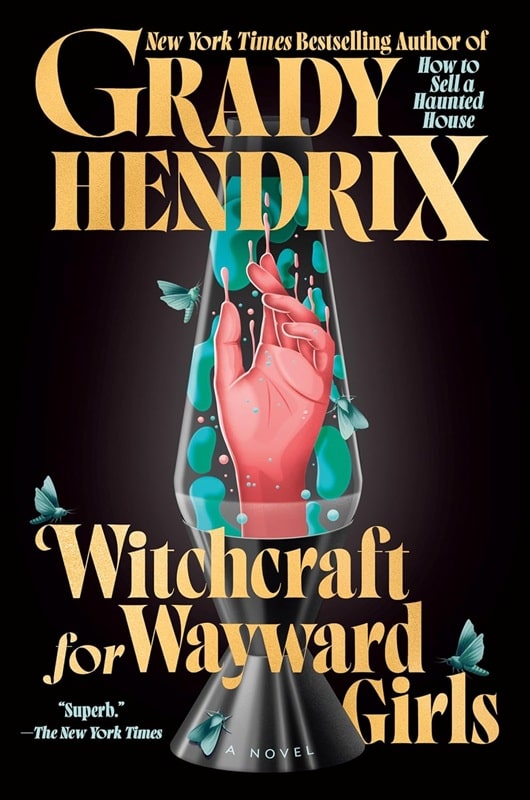
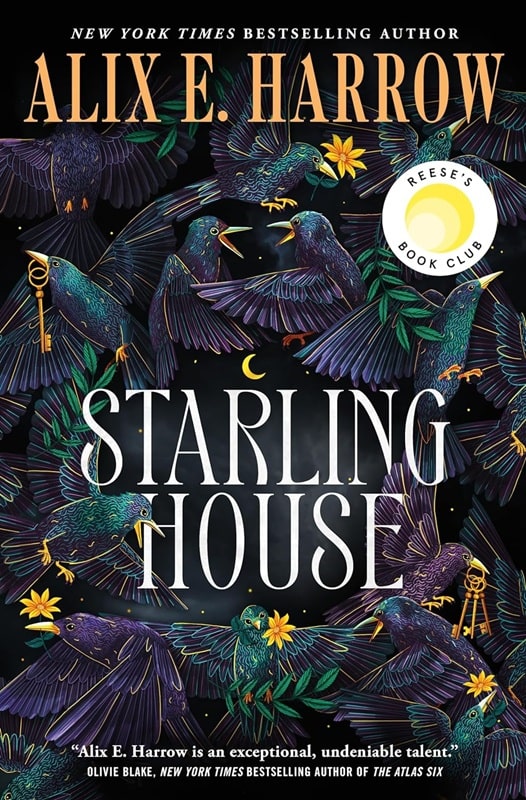
Witchcraft for Wayward Girls by Grady Hendrix (Berkley, January 14, 2025) and
Starling House by Alix E. Harrow (Tor Books, October 3, 2023). Covers: uncredited, Micaela Alcaino
No, not that kind of house of ill repute (though I confess I thought the semi-salacious implication of the headline might get some of you to read a bit further, though of course not you who are reading this now, just all those others). Rather the gothic trope of the creepy house, the mansion where ancestral secrets lie, where bad things happen. From The House of Seven Gables to The Fall of the House of Usher to Wuthering Heights to more contemporary (all the more so because they actually existed) houses of horror such as Colson Whitehead’s Nickel Academy and Tananarive Due’s Dozier School of Boys, these are places that present a facade of safety, but are far from it.
That’s the kind of house found in Grady Hendrix’s Witchcraft for Wayward Girls. Don’t be put off by the middle school YA sounding title. Homes for “wayward girls” actually existed in mid-20th century Florida. It was where unmarried pregnant teenagers were sent to have their babies, give them up for adoption, and then return to “normal” life with their and their family’s “reputations” intact.
The adolescent pregnant girls, literally abandoned by her parents for committing a sexual and “moral” offense (to my knowledge, there were no homes for boys who fathered out-of-wedlock babies and put the mothers in this position) became subject to “we know what’s best for you” treatment and holier-than-thou attitudes. In all too many cases, preserving the girl’s good name and future marriageability provided cover for the lucrative practice of selling newborns to adoptive parents on top of charging parents for room and board and, above all, discretion.
As Hendrix points out in an afterword,
Most homes confined their girls to the property… [some] forbade the use of makeup, censored the girls’ mail, charged them extra for dessert, and refused to allow them any communication with the outside world…Girls who changed their minds about adoption and tried to keep their babies would be subject to a tactic a tactic informally known as “The Bill.” At the last minute, a caseworker or staff member would inform the girl that her accumulated charges had to be paid before she could go home with their child. The Bill was usually so high that a girl had no hope of paying and so, whether she wanted to or not, she had to allow her baby to be put up for adoption.
This kind of house already earns its horrific bona fides without need of supernatural intervention (indeed, Hendrix says the first two drafts didn’t contain any fantastical elements). Adding witchcraft, however, layers a metaphor for women’s empowerment, albeit one that carries a price, that is closely associated in folklore with childbirth. As Hendrix notes,
There’s a popular [though discredited] myth that the Catholic Church targeted midwives as witches… In fairy tales, witches are constantly eating or stealing babies. In the fevered popular imagination, witches crown their black sabbaths with a child sacrifice.
The story centers on Fern (all the girls are given an arbitrary plant-based pseudonym during their stays, ostensibly to preserve privacy, but actually to depersonalize them), a 15 year old in effect kidnapped by her father to endure her pregnancy at the Wellwood House in St. Augustine, Florida in the summer of 1970. Her situation is not, needless to say, a happy one.
No one would write, no one would call, no one outside this house even knew where she was, except her dad, and he hated her. She never felt more alone. She would do whatever they wanted her to say, eat whatever they told he to ear, just so long as they let her of back to the way thing were before.
The smart-assed (if ultimately superficial) hippie-styled resistance of a fellow wayward girl provides some hope of eventual escape from the home’s adult “benefactors.” But it is a bookmobile librarian who hands Fern a tome entitled How to be a Groovy Witch that leads to the invocation of witchcraft to avenge mistreatment.
Unfortunately, to paraphrase Peter Parker, with great power comes unexpected consequences and questions of responsibility. And just as it’s one thing to proclaim hippie slogans and quite another to actually adhere to them in the real world, practicing witchcraft also comes with significant moral compromises. Which Fern must balance against the familial and social stigma of unwed pregnancy, of being forced to give birth and then relinquish her child. As once of the wayward girls now an adult and long after giving up her baby puts it:
There’s a part of me that’ll always be seventeen. A part of me that’ll be seventeen forever, locked away in that Home, cut off from the world.
That’s a house you can run away from, but never escape.
Locked away and cut off from the world is also the predicament in Alix E. Harrow’s The Starling House. Instead of the proverbial madwoman in the attic, it’s a male recluse in the titular creepy home containing disturbing secrets. Another kind of forced habitation is the stifling town, the ironically named Eden, Kentucky, modeled somewhat after the equally ironically named and actual Paradise, Kentucky immortalized in the John Prine song about a family-owned coal company that exploits the land and resident workers. It’s a place Kentucky native Harrow knows as “a place of very mixed experiences that I love very, very, very much, and which has just an incredible violence and terror to it.”
Our heroine, Opal, is a social malcontent and for the most part first-person narrator (there are also point of view shifts and even footnotes and a bibliography!), a high school dropout working a dead-end job in a dead end town. Orphaned following her mother’s death in a car crash, she is trying to save up money to send younger brother Jasper to a private school and get a better life out of Eden. But kind of hard to do on a Tractor Supply cashier’s salary and some petty larceny.
Walking to work, Opal finds herself strangely (of course) drawn to the ancestral home of the Starling family, one of whom wrote a dark fantasy for children called The Underland (the book’s illustrations appear throughout) and disappeared under, of course, mysterious circumstances. Part of the house’s appeal to Opal is how the shapes on the front gate remind her of the creatures depicted in The Underland.
The gates of Starling House don’t look like much from a distance — just a dense tangle of metal half-eaten by rust and ivy, held shut by a padlock so large it almost feels rude — but up close you can make out individual shapes: clawed feet and legs with too many joints, scaled backs and mouths full of teeth, heads with empty holes for eyes.
Opal feels compelled to look inside the old neglected house, managing to convince the current Warden, Arthur Starling, despite his initial misgivings, to hire her as a housekeeper. Opal soon discovers a special strange connection to the equally strange house. And to Arthur.
Sinister forces soon intercede, however. The aptly named Gravely Power company wants to acquire the Starling House property by means fair or foul. And then there are supernatural entities literally right out of The Underling. All of which jeopardize Opal’s already problematic relationship with Arthur.
The Starling House has rooms for just about everything — Southern gothic horror, classic fairy tale, corporate evil, environmental and class issues, a love story even (it’s not coincidental that Harrow makes a point of mentioning in the Acknowledgement that her mother “read every version of Beauty and the Beast with me”), all wrapped together in a single, ahem, attractive property. It’ll particularly resonate with anyone who grew up in a small town or boring subdivision who tried to run away from the horror of humdrum existence.
David Soyka is one of the founding bloggers at Black Gate. He’s written over 200 articles for us since 2008. His most recent was a review of The Bright Sword by Lev Grossman.
18 Lectures in “Immemorial” Shine A Light | Making Memories For Our Future
Immemorial is a synthesis of reporting, memoir, and essay, reflecting on the design and function…
The post 18 Lectures in “Immemorial” Shine A Light | Making Memories For Our Future appeared first on LitStack.
Spotlight on “Making History” in Paperback by Richard Cohen
Making History is an exploration of who gets to record the world’s history—from Julius Caesar…
The post Spotlight on “Making History” in Paperback by Richard Cohen appeared first on LitStack.
A (Black) Gat in the Hand: Weird Tales Rings in Conan
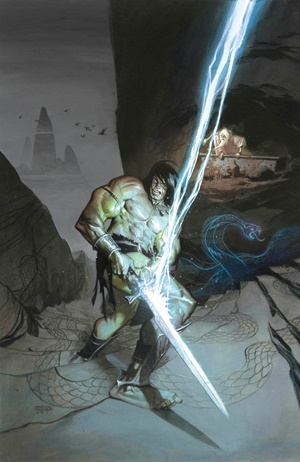 “You’re the second guy I’ve met within hours who seems to think a gat in the hand means a world by the tail.” – Phillip Marlowe in Raymond Chandler’s The Big Sleep
“You’re the second guy I’ve met within hours who seems to think a gat in the hand means a world by the tail.” – Phillip Marlowe in Raymond Chandler’s The Big Sleep
(Gat — Prohibition Era term for a gun. Shortened version of Gatling Gun)
Back in 2018, I started A (Black) Gat in the Hand because I wanted to share my love of hardboiled Pulp. I’ve had some friends join in, and they’ve added some non-hardboiled Pulp, while I’ve expanded my coverage. I’m currently working on my third Kirby O’Donnell essay, and my first on Harold Lamb, which takes us to the Adventure Pulps. And I’m starting another Robert E. Howard Weird Menace post, looking at his occult investigators, Conrad and Kirowan.
One of those stories has a direct link to Conan! A key part of that one is The Ring of Thoth Amon. And if you like the mighty-thewed Cimmerian, you know that ring is integral to the very first Conan tale, “The Phoenix on the Sword.”
Two years before I kicked off my Pulp series under the first title of With A (Black) Gat, I wrote one of the very first essays for Hither Came Conan. Six years ago now, I ruminated on “The Phoenix on the Sword.” I like that story quite a bit. So, we’re bringing that post back for the Summer Pulp series, while I work on the second life of The Ring of Thoth Amon.
I’m pretty sure “Phoenix” was the first Conan story I read. Now, it might have been “The Thing in the Crypt,” in the first Lancer/Ace collection, which I had bought and then stuck on a shelf for at least a decade or two. But I didn’t remember that story when I started going through the Ace books, AFTER exploring Conan via the Del Rey trilogy. So, I think it was “Phoenix.”
The Phoenix on the Sword
It is well known that “The Phoenix on the Sword,” the first story of Conan the Cimmerian, was a rewrite of a previously unsold tale of an earlier Howard character, Kull, an exile from Atlantis.
Howard sold three Kull stories to Weird Tales, appearing in the August and September issues of 1929, and finally, in November of 1930. Howard also wrote nine more tales about the character, which were not published until after his death. So, only 25% of his Kull stories sold. Not exactly a money-maker.
However, “By This Axe I Rule!”, which had failed to sell to Argosy and Adventure, was dusted off to feature a less-philosophical barbarian.
I struggled through the Kull Canon. I definitely prefer Conan, Solomon Kane, and El Borak. The Kull stories seem, to me, to be overly philosophical and full of metaphysical meanderings. “The Mirrors of Tuzun Thune,” which actually appeared in Weird Tales, is one of my least favorite of Howard’s published work. Kull stares in mirrors all day, waxing thoughtful. It’s mind-numbingly dull.
SPOILER ALERT – You absolutely should already have read the original REH story, before reading this essay. Reading on before reading Howard’s “The Phoenix on the Sword” makes no sense at all. You’re definitely gonna ruin the story. END OF SPOILER ALERT.
The heart of “Axe!” and “Phoenix” is the same. A barbarian has taken the kingship of a civilized nation by the sword. He is hailed as a liberator at first, but his status as an outsider and a savage undermines his rule. A coalition of malcontents, led by one Ascalante, plots to assassinate him in his rooms at night: both stories include a banished former noble now outlaw; a useless noble with a faint trace of royal blood in his veins; a dwarf noble with waning influence and declining wealth; an ambitious military commander; and a fool-headed minstrel. That part of the story is all but the same, even to a bribed officer of the guard leading away the royal bodyguard and disappearing forever (smart guy).
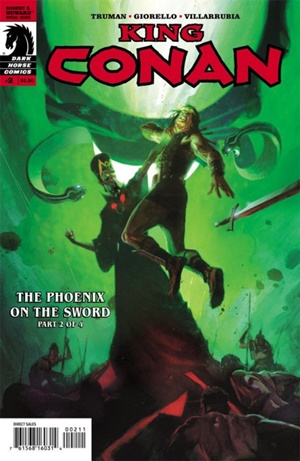 The fight, when the conspirators, with 16 nameless rogues to help, invade the royal bedchamber, is pretty much the same in both stories. Well, to a point…
The fight, when the conspirators, with 16 nameless rogues to help, invade the royal bedchamber, is pretty much the same in both stories. Well, to a point…
Where the “Phoenix” varies is that, in replacing Kull with Conan, Howard makes it a sword and sorcery story. The subplot in “By This Axe I Rule!” involves a young noble, Seno val Dor, who wants to marry Ala, a slave girl. However, such a union is forbidden by Valusian law. And law is inviolate. Even the king is helpless to change it. Seno and Ala cannot wed.
Kull fights off the almost two-dozen invaders, until only Ascalante remains. The rebel has the advantage, until Seno arrives and slays the would-be assassin with a thrown dagger. Ala had overheard the plot and gone to her beloved, who gathered up his men and rushed to the king’s aid.
Kull, wounded and weak, orders the tablet regarding the law of slaves to be brought to him. Once that’s done, he lets his thoughts be known:
“Hear you! I am weary of this business! I am no king but a slave! I am hemmed in by laws, laws, laws! I cannot punish malefactors nor reward my friends because of law – custom – tradition! By Valka, I will be king in fact as well as name!”
He declares that Seno and Ala saved his life, and they may marry. This does not go over well with the traditionalists, as you can well imagine. The king is… unperturbed.
‘”I am the law!” roared Kull, swinging up his axe; it flashed downward and the stone tablet flew into a hundred pieces. The people clenched their hands in horror, waiting dumbly for the sky to fall.’
Thinking outside the box was not exactly encouraged in Valusia.
The speech continues as Kull drives his point home, tossing aside the royal scepter and brandishing the bloody axe. At the end of the story, it’s clear he will rule, enforcing those laws he declares just and discarding those he does not. It certainly seems like the blueprint for an unchallenged despot.
It’s actually a decent enough read and not a bad story.
But for “The Phoenix on the Sword,” Howard completely tosses out the noble-slave love story and the discourse on the suffocating effects of unalterable law. Instead, he brings in the fantastic, making it a sword and sorcery tale.
Now, Conan does wax eloquent on the duties of kingship, just as Kull did. This:
“The trouble with me, Brule – I did not dream far enough. I always visualized merely seizing the throne -I did not look beyond. When King Borna lay dead beneath my feet, and I tore the crown from his gory head, I had reached the ultimate border of my dreams. From there, it has been a maze of illusions and mistakes. I prepared myself to seize the throne – not to hold it.”
Became this:
“I did not dream far enough, Prospero. When King Numedides lay dead at my feet and I tore the crown from his gory head and set it on my own, I had reached the ultimate border of my dreams. I had prepared myself to take the crown, not to hold it. In the old days all I wanted was a sharp sword and a straight path to my enemies. Now the path is straight and my sword is useless.”
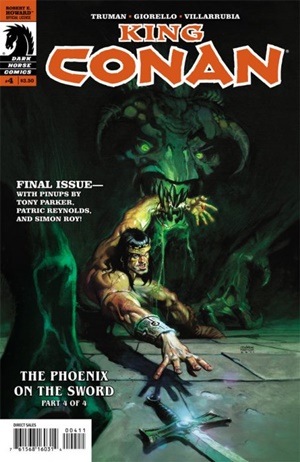 Pretty much the same thing. Though, the writing is a little bit better in the second version. Howard continually honed his skill.
Pretty much the same thing. Though, the writing is a little bit better in the second version. Howard continually honed his skill.
But while the focus of the remainder of the Kull story is instead of fretting over his limitations as king, Howard has Conan dream.
Now, this little dream interlude matters, because Ascalante has a slave named Thoth-Amon. A Stygian, he was once a powerful sorcerer, but he had lost his magical Ring of Set, and was now weak, and in hiding. He is sent to accompany Dion, the totally useless noble, to make sure that the latter doesn’t expose the plot. Dion, who is beyond clueless, has the very ring Thoth Amon seeks. Quickly reclaiming it with a dagger, the sorcerer turns to revenge against Ascalante, using his once-lost dark arts. Unfortunately for Conan, he’s only a few feet away from the potential royal usurper. He’s definitely in the neighborhood of being collateral damage.
Howard was the best prose writer I’ve discovered yet in the fantasy field. He just had a fantastic way with words:
“There was a movement about him, such a swirl as is made in water when some creature rises to the surface. A nameless, freezing wind blew on him briefly, as if from an opened Door. Thoth felt a presence at his back, but he did not look about. He kept his eyes fixed on the moonlit space of marble, on which a tenuous shadow hovered. As he continued his whispered incantations, this shadow grew in size and clarity, until it stood out distinct and horrific. Its outline was not unlike that of a gigantic baboon, but no such baboon ever walked the earth, not even in Stygia. Still, Thoth did not look, but drawing from his gridle, a sandal of his master – always carried in the dim hope that he might be able to put it to such use – he cast it behind him.”
From Thoth Amon staring at the ring he has longed for, through the beast passing by a stunned guard at the palace (which ends chapter three), this is a terrific sequence of writing.
Meanwhile, asleep in his chamber, Conan travels to a magnificent tomb. There he meets the long-dead sage, Epemitrius, who, during his life, fiercely battled the evil snake-god, Set. Epemitrius etches the symbol of a phoenix onto Conan’s sword. Then, Conan wakes in his room and hears stealthy footsteps in the corridor and begins to prepare himself for combat.
The battle scene is similar in both versions, with Kull and Conan trying to avoid harming the mad minstrel (I found that whole ‘a minstrel is greater than a king’ something more fitting for de Camp and Carter than Howard, myself).
With all the rogues either dead or fled (hey, that rhymed!), Ascalante gains the advantage and is about to kill Kull in the original version. Only to have Sena save the day. But there is no Sena and Ala in Conan’s version. And while I think it has been good up to this point, it is here that “The Phoenix on the Sword” really shines and we see Robert E. Howard’s emergence as one of the greatest fantasy writers.
Conan uses his axe-arm to wipe blood from his eyes at precisely the wrong moment. Ascalante, alone and with nothing to lose, rushes at him. The would-be assassin doesn’t quite make it there:
“But even as he began his charge, there was a strange rushing in the air and a heavy weight struck terrifically between his shoulders. He was dashed headlong and great talons sang agonizingly in his flesh. Writhing desperately beneath his attacker, he twisted his head about and started into the face of Nightmare and lunacy. Upon him crouched a great black thing which he knee was born in no sane or human world. Its slavering black fangs were near his throat and the glare of its yellow eyes shriveled his limbs as a killing wind shrivels young corn. The hideousness of its face transcended mere bestiality.”
“In those abhorrent features the outlaw’s dilated eyes seemed to see, like a shadow in the madness that enveloped him, a faint and terrible resemblance to the slave Thoth-Amon.”
I mean, WOW!!! (Yeah, I know. My keen analysis is breathtaking…)
Ascaltante dies of sheer terror: “Then, Ascalante’s cynical and all-sufficient philosophy deserted him, and with a ghastly cry he gave up the ghost before those slavering fangs touched him.”
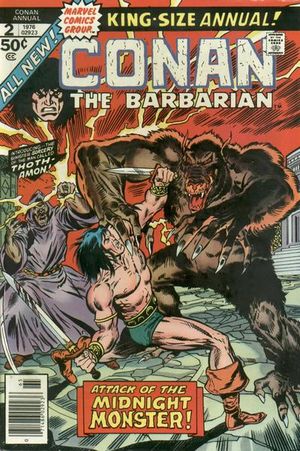 Howard had developed Ascalante in this short story. He is not just a paper-thin supporting character. And he did a fantastic job of having the man, in the absolute horror of his final moments, get at least a flickering understanding that his slave had gotten his revenge. And then, he dies. It’s brilliant work.
Howard had developed Ascalante in this short story. He is not just a paper-thin supporting character. And he did a fantastic job of having the man, in the absolute horror of his final moments, get at least a flickering understanding that his slave had gotten his revenge. And then, he dies. It’s brilliant work.
Which leaves a ‘frozen’ Conan to face this new threat. And in just THREE paragraphs, Howard gives us a marvelous fight between the Cimmerian and the supernatural creature. At this point, I think that “Phoenix” is simply a much more interesting and entertaining story than “Axe!” was.
The creature would have killed Conan, if not for the phoenix etched on his sword by Epimetrius. That allowed the weapon, even though broken earlier in the fight, to fatally wound it.
I think that “By This Axe I Rule!” Is a good enough story. Though, it’s not one I would turn back to very often. Whereas, I’ve re-read “The Phoenix on the Sword” quite a few times. In large part, because I like the swords and sorcery aspect of it.
Thoth Amon was the catalyst, though not actually present, in “The God in the Bowl.” So, Howard had him in mind for two of the first three Conan tales. But he never again used the Stygian sorcerer. And since “Bowl” was rejected by Wright and not published until 1952, he was effectively a one-shot character in the authentic Conan Canon.
That changed, however, when L. Sprague de Camp decided to make him the main antagonist in the barbarian’s life, as he laid out the original and ‘new’ tales as a Conan Saga. The Marvel comics also utilized Thoth Amon, so that he is now generally considered ‘the’ Conan villain.
While it’s not the best Conan story written by Howard, I do think it’s the perfect introduction to Conan. He already has many exploits behind him and is now a king. It’s got a royal assassination plot: and sorcery. And it has the quality writing characteristic of much of Howard’s work.
2025 (3)
Shelfie – Dashiell Hammett
Windy City Pulp & Paper Fest – 2025
Will Murray on Who was N.V. Romero?
2024 Series (11)
Will Murray on Dashiell Hammett’s Elusive Glass Key
Ya Gotta Ask – Reprise
Rex Stout’s “The Mother of Invention”
Dime Detective, August, 1941
John D. MacDonald’s “Ring Around the Readhead”
Harboiled Manila – Raoul Whitfield’s Jo Gar
7 Upcoming A (Black) Gat in the Hand Attractions
Paul Cain’s Fast One (my intro)
Dashiell Hammett – The Girl with the Silver Eyes (my intro)
Richard Demming’s Manville Moon
More Thrilling Adventures from REH
Prior Posts in A (Black) Gat in the Hand – 2023 Series (15)
Back Down those Mean Streets in 2023
Will Murray on Hammett Didn’t Write “The Diamond Wager”
Dashiell Hammett – ZigZags of Treachery (my intro)
Ten Pulp Things I Think I Think
Evan Lewis on Cleve Adams
T,T, Flynn’s Mike & Trixie (The ‘Lost Intro’)
John Bullard on REH’s Rough and Ready Clowns of the West – Part I (Breckenridge Elkins)
John Bullard on REH’s Rough and Ready Clowns of the West – Part II
William Patrick Murray on Supernatural Westerns, and Crossing Genres
Erle Stanley Gardner’s ‘Getting Away With Murder (And ‘A Black (Gat)’ turns 100!)
James Reasoner on Robert E. Howard’s Trail Towns of the old West
Frank Schildiner on Solomon Kane
Paul Bishop on The Fists of Robert E. Howard
John Lawrence’s Cass Blue
Dave Hardy on REH’s El Borak
Prior posts in A (Black) Gat in the Hand – 2022 Series (16)
 Asimov – Sci Fi Meets the Police Procedural
Asimov – Sci Fi Meets the Police Procedural
The Adventures of Christopher London
Weird Menace from Robert E. Howard
Spicy Adventures from Robert E. Howard
Thrilling Adventures from Robert E. Howard
Norbert Davis’ “The Gin Monkey”
Tracer Bullet
Shovel’s Painful Predicament
Back Porch Pulp #1
Wally Conger on ‘The Hollywood Troubleshooter Saga’
Arsenic and Old Lace
David Dodge
Glen Cook’s Garrett, PI
John Leslie’s Key West Private Eye
Back Porch Pulp #2
Norbert Davis’ Max Latin
Prior posts in A (Black) Gat in the Hand – 2021 Series (7 )
The Forgotten Black Masker – Norbert Davis
Appaloosa
A (Black) Gat in the Hand is Back!
Black Mask – March, 1932
Three Gun Terry Mack & Carroll John Daly
Bounty Hunters & Bail Bondsmen
Norbert Davis in Black Mask – Volume 1
Prior posts in A (Black) Gat in the Hand – 2020 Series (21)
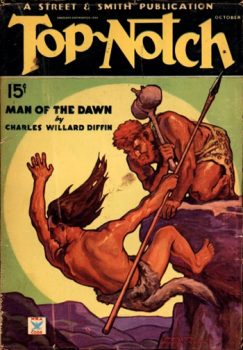 Hardboiled May on TCM
Hardboiled May on TCM
Some Hardboiled streaming options
Johnny O’Clock (Dick Powell)
Hardboiled June on TCM
Bullets or Ballots (Humphrey Bogart)
Phililp Marlowe – Private Eye (Powers Boothe)
Cool and Lam
All Through the Night (Bogart)
Dick Powell as Yours Truly, Johnny Dollar
Hardboiled July on TCM
YTJD – The Emily Braddock Matter (John Lund)
Richard Diamond – The Betty Moran Case (Dick Powell)
Bold Venture (Bogart & Bacall)
Hardboiled August on TCM
Norbert Davis – ‘Have one on the House’
with Steven H Silver: C.M. Kornbluth’s Pulp
Norbert Davis – ‘Don’t You Cry for Me’
Talking About Philip Marlowe
Steven H Silver Asks you to Name This Movie
Cajun Hardboiled – Dave Robicheaux
More Cool & Lam from Hard Case Crime
A (Black) Gat in the Hand – 2019 Series (15)
Back Deck Pulp Returns
A (Black) Gat in the Hand Returns
Will Murray on Doc Savage
Hugh B. Cave’s Peter Kane
Paul Bishop on Lance Spearman
A Man Called Spade
Hard Boiled Holmes
Duane Spurlock on T.T. Flynn
Andrew Salmon on Montreal Noir
Frank Schildiner on The Bad Guys of Pulp
Steve Scott on John D. MacDonald’s ‘Park Falkner’
William Patrick Murray on The Spider
John D. MacDonald & Mickey Spillane
Norbert Davis goes West(ern)
Bill Crider on The Brass Cupcake
A (Black) Gat in the Hand – 2018 Series (32)
George Harmon Coxe
Raoul Whitfield
Some Hard Boiled Anthologies
Frederick Nebel’s Donahue
Thomas Walsh
Black Mask – January, 1935
Norbert Davis’ Ben Shaley
D.L. Champion’s Rex Sackler
Dime Detective – August, 1939
Back Deck Pulp #1
W.T. Ballard’s Bill Lennox
Erle Stanley Gardner’s The Phantom Crook (Ed Jenkins)
Day Keene
Black Mask – October, 1933
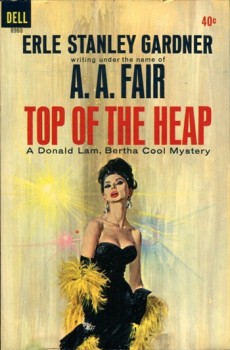 Back Deck Pulp #2
Back Deck Pulp #2
Black Mask – Spring, 2017
Erle Stanley Gardner’s ‘The Shrieking Skeleton’
Frank Schildiner’s ‘Max Allen Collins & The Hard Boiled Hero’
A (Black) Gat in the Hand: William Campbell Gault
A (Black) Gat in the Hand: More Cool & Lam From Hard Case Crime
MORE Cool & Lam!!!!
Thomas Parker’s ‘They Shoot Horses, Don’t They?’
Joe Bonadonna’s ‘Hardboiled Film Noir’ (Part One)
Joe Bonadonna’s ‘Hardboiled Film Noir’ (Part Two)
William Patrick Maynard’s ‘The Yellow Peril’
Andrew P Salmon’s ‘Frederick C. Davis’
Rory Gallagher’s ‘Continental Op’
Back Deck Pulp #3
Back Deck Pulp #4
Back Deck Pulp #5
Joe ‘Cap’ Shaw on Writing
Back Deck Pulp #6
The Black Mask Dinner

Bob Byrne’s ‘A (Black) Gat in the Hand’ made its Black Gate debut in 2018 and has returned every summer since.
His ‘The Public Life of Sherlock Holmes’ column ran every Monday morning at Black Gate from March, 2014 through March, 2017. And he irregularly posts on Rex Stout’s gargantuan detective in ‘Nero Wolfe’s Brownstone.’ He is a member of the Praed Street Irregulars, founded www.SolarPons.com (the only website dedicated to the ‘Sherlock Holmes of Praed Street’).
He organized Black Gate’s award-nominated ‘Discovering Robert E. Howard’ series, as well as the award-winning ‘Hither Came Conan’ series. Which is now part of THE Definitive guide to Conan. He also organized 2023’s ‘Talking Tolkien.’
He has contributed stories to The MX Book of New Sherlock Holmes Stories — Parts III, IV, V, VI, XXI, and XXXIII.
He has written introductions for Steeger Books, and appeared in several magazines, including Black Mask, Sherlock Holmes Mystery Magazine, The Strand Magazine, and Sherlock Magazine.
You can definitely ‘experience the Bobness’ at Jason Waltz’s ’24? in 42′ podcast.
Book Review: Shield of Sparrows by Devney Perry
I received a review copy from the publisher. This does not affect the contents of my review and all opinions are my own.
 Shield of Sparrows by Devney Perry
Shield of Sparrows by Devney Perry
Mogsy’s Rating: 4 of 5 stars
Genre: Romance, Fantasy
Series: Book 1
Publisher: Red Tower Books (May 6, 2025)
Length: 528 pages
Author Information: Website | Twitter
The romantasy genre is more crowded than ever these days, so whenever one stands out, I tend to take notice! While a novel like Shield of Sparrows by Devney Perry may follow a familiar blueprint, it manages to execute it with enough style and panache to feel instantly recognizable but not stale. To my delight, I had a great time with it.
The book follows Princess Odessa, the eldest daughter of the king of Quentis who has spent most of her life in the shadow of her younger half-sister. After all, it is Mae who is the favored child, the one promised to the prince of neighboring Turah, and the one carefully trained to become a spy and uncover the rival kingdom’s deepest secrets. However, when the time finally comes to seal the alliance through marriage, the Turan prince Zavier unexpectedly invokes an ancient rite that allows him to choose Odessa as his bride instead, much to everyone’s surprise.
And thus, with little warning, our protagonist is shipped off to a foreign land alongside her new husband and his loyal soldier, known only as the Guardian. Tasked with furthering her father’s political agenda, Odessa must quickly learn to navigate the unfamiliar ways of the Turan court if she is to one day become their queen, except this is proving far more difficult and treacherous than she ever imagined. While Prince Zavier remains distant and tightlipped about the problems plaguing his kingdom, monsters stalk the wilds and prey on his people, and a mysterious illness spreading across Turah is corrupting everything it touches. At the heart of it all stands the enigmatic Guardian, bound to protect the royal couple yet is shrouded in secrets of his own. Although his insufferable personality constantly frustrates Odessa, it appears that their paths—and perhaps even their destinies—may be inextricably linked.
Through all of this, the main character’s journey gives readers a fast-paced entry into the fantasy world of Shield of Sparrows. Rather than packing her prose with exposition, Perry lets us explore the magic of it on our own, discovering a wondrous landscape featuring mythical beasts and layers of rich history. While the slow trickle of information can sometimes make you feel impatient, the steady ramp up is well worth it in the end as it leads to a result that is both epic and cinematic.
But of course, what everyone wants to know is, how is the romance? I have to say, the character work is where this novel is strongest. First, we have Odessa, a heroine who is initially perceived as unassuming and weak, but her growth over the course of the story is realistic and tangible. Similarly, the book’s romantic arc, which ultimately ends up being between her and the Guardian, is very well written and deliciously paced—no frivolous claims of being slow-burn in the publisher description only to end up being insta-love, thank goodness. Their love story is one that unfolds through sharp dialogue and moments of mutual vulnerability, but the drama never feels intrusive, nor does it ever overwhelm the conflicts that drive the main plot. Sure, there’s still plenty of manufactured angst stemming from dumb reasons like miscommunication and the deliberate withholding of truth, but at least we got a few genuine twists and surprises out of it.
That said, in terms of storytelling, Shield of Sparrows is in no way reinventing the wheel. Still, there are sufficient emotional beats to keep things entertaining and fresh, with thrills frequently injected in the form of monster attacks and court intrigue. Plus, Odessa’s unique experiences in Turah alone are enough to give this story its staying power, not to mention the evolving relationships she builds along the way. Admittedly, the pacing could have used some tweaking, particularly the middle section where the plot meandered and momentum faltered, or the ending where things went the other direction and became pure pandemonium in an instant. Ultimately though, these are relatively minor quibbles.
In short, Shield of Sparrows might not break new romantasy ground, but it doesn’t have to. Genre fans will be happy that it hits all the right notes and provides plenty of reasons to crave the next book. The ending left me reeling, and after all that chaos, I’m going to need some answers.
![]()
![]()
A Challenge Worth Smiling About: Tim Waggoner on Writing Conan

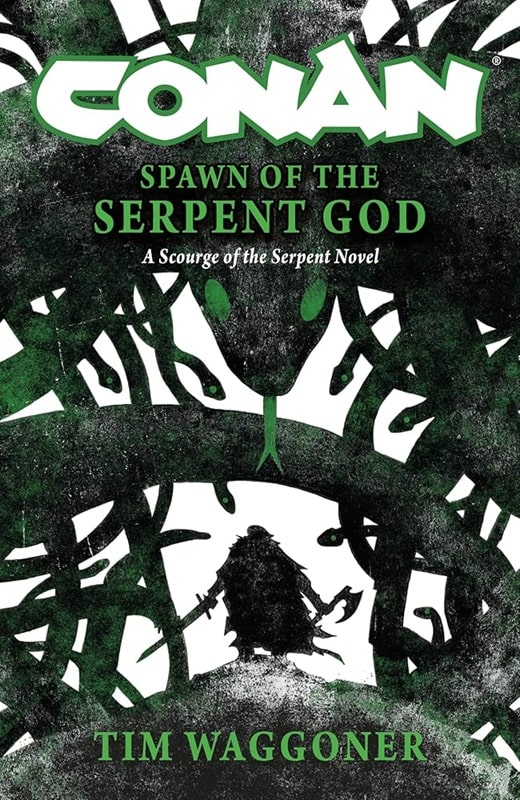
Tim Waggoner, and his upcoming novel Conan: Spawn of the Serpent God (Titan Books, October 28, 2025)
On a non-descript day I am intercepted on entering a coffee shop. It turns out to be a happy accident, an old colleague, eager to join me as I wait for my next interview to begin. The distraction is welcome but doesn’t help much. My interviewee isn’t late but they aren’t early either and I’m beginning to get nervous.
“You’re waiting for him, aren’t you?” the friend asks.
Neither of us mentioned his name because we didn’t have to. Some things, in certain contexts, go together like cheese and tortillas. With four Stoker Awards and many great novels to his name, Tim Waggoner has developed that kind of reputation in this part of Ohio. If Massachusetts is Lovecraft Country then downtown Dayton is Waggonerstan.
[Click the images for Conan-sized versions.]
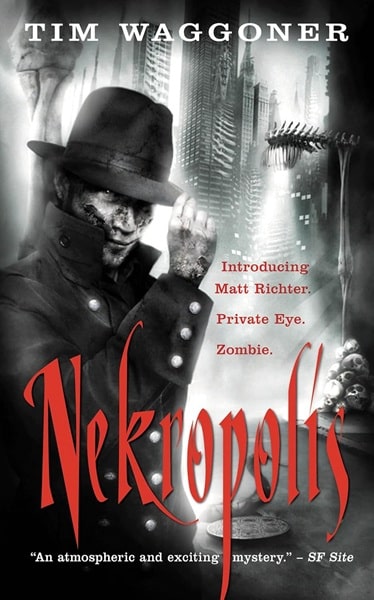
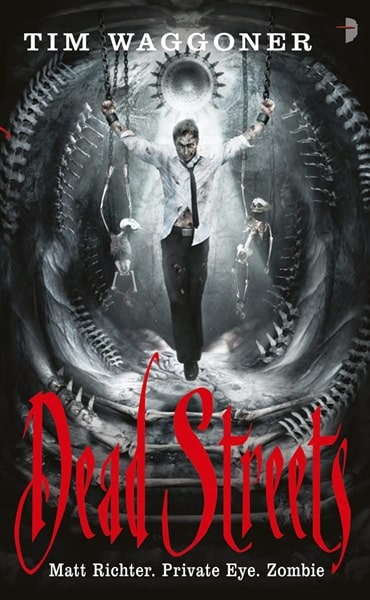
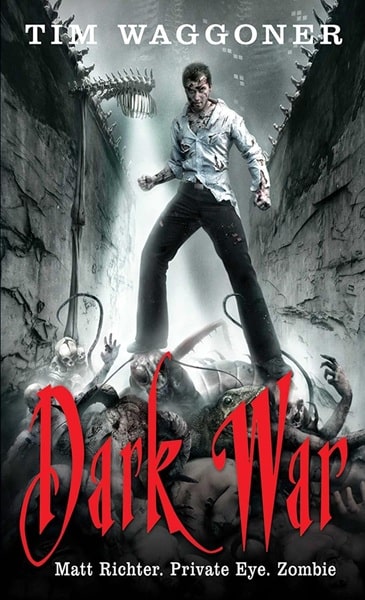
The Nekropolis series by Tim Waggoner: Nekropolis, Dead Streets, and
Dark War (Angry Robot, 2009, 2010, and 2011). Covers by Vincent Chong
“What’s the interview about?”
I swerve the question because this former colleague is a journalist too. When it comes to what Waggoner has to say about the novel we’ve come to talk about, I’d rather get it in Black Gate first. A book the author later estimates is the 62nd or 63rd of his career.
That brief period of forbearance is soon rewarded when Waggoner arrives. I can tell he’s been busy cooking up something special with his new novel. It does not take long before coffee and talk of Conan begins to flow.
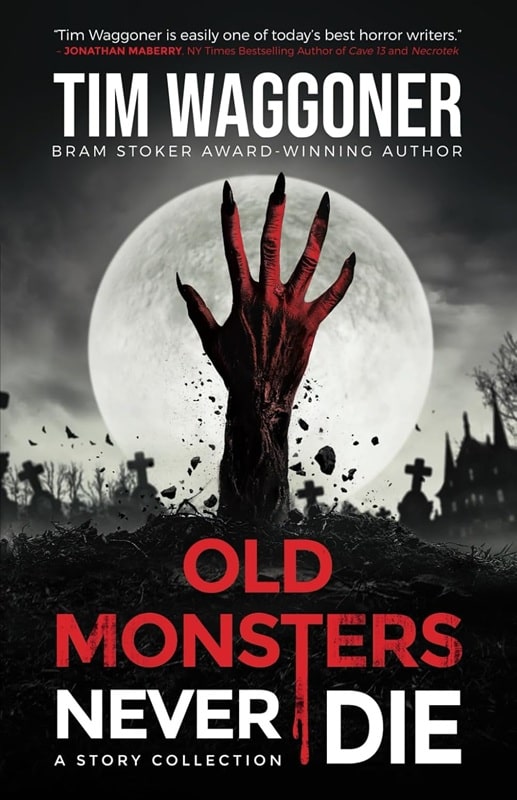
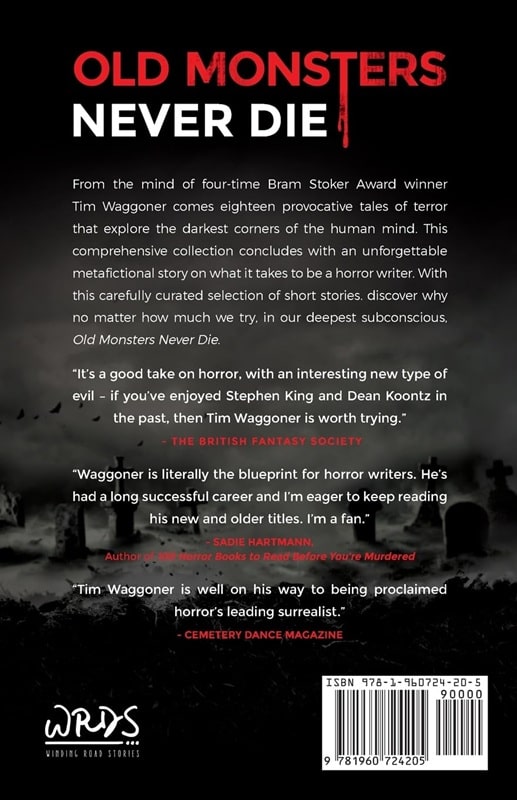
Old Monsters Never Die: A Story Collection by Tim Waggoner
(Winding Road Stories, May 24, 2024). Cover art uncredited
Anyone familiar with Waggoner’s literary career knows he’s worn many hats over the years, dipping his proverbial toe in one genre or another. There’s the Nekropolis series, the fantasy Blade of the Flame novels, and award-winning books on the craft of writing such as Writing in the Dark. Even among those massive projects, trilogies, and the travails every writer faces, working on a Conan novel was a special challenge. In fact, that’s exactly why the first time opportunity came knocking he said no.
“My agent told me Titan was doing Conan and asked if I was interested. I just thought there was no way I could do it because it’s not just about Conan but also the world he inhabited. It’s a very realized world with multiple countries. I just didn’t know if I could do it. After saying no the first time, when I was asked again I just had to do it. I said yes and immersed myself in all the Conan stories I could,” Waggoner told me.
That meant diving deep into the lore of the famous barbarian, going back to the original stories and working his way up to Titan’s ongoing series. It’s clear, however, that like many fantasy fans Waggoner was not coming to Conan blind. This certainly wasn’t his first time in the Hyborian Age.
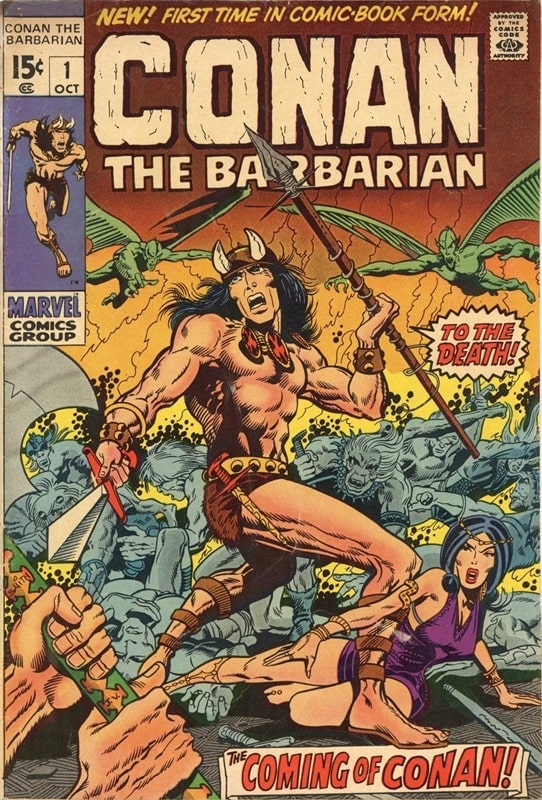

Marvel Comics Conan the Barbarian, issue #1 (Marvel Comics, October, 1970). Cover by Barry Windsor-Smith
“Most of my experience with Conan had been with the comics. As a kid I knew him mostly through Marvel Comics. I had the very first issue for years and wish I’d kept it. I don’t know what happened to it. Probably fell apart I read it so often.”
Through cultural osmosis he learned more about the character through films and other comics. But going back to the original well of creativity that spawned one of fantasy’s greatest protagonists taught him a lot that would serve him well during the writing process. He listened to them on audiobook and read them at home. Waggoner also went on to read the King Kull stories, El Borak, and even Solomon Kane. But it was the stories about Conan that were most integral.
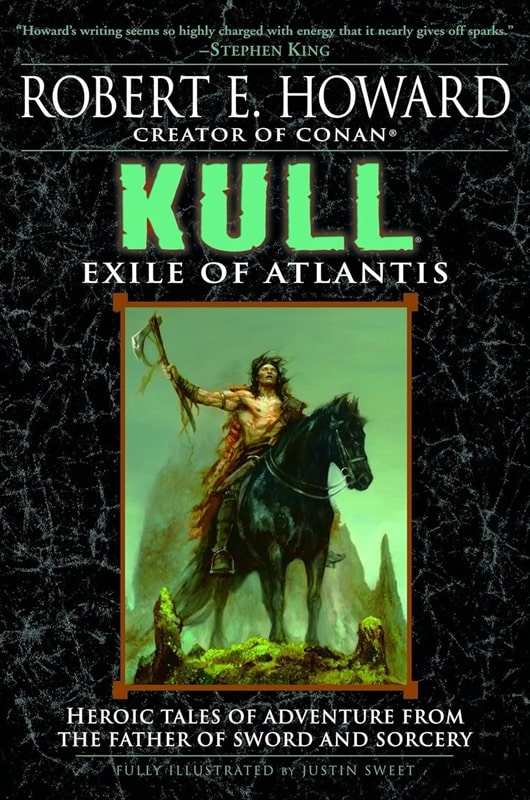
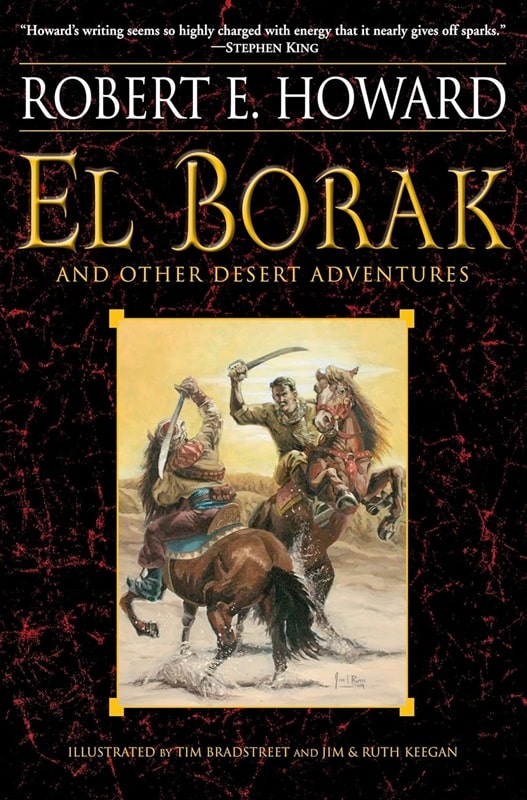
Two Del Rey Robert E. Howard volumes: Kull: Exile of Atlantis, and El Borak and Other Desert
Adventures. (October 31, 2006, and February 9, 2010). Covers by Justin Sweet, and Jim & Ruth Keegan
“It really helped me because the one thing I didn’t get in the comics or in the movies is how much a part of the story the setting is,” he said. “It took me forever to get started on it. I couldn’t figure out where to start but eventually it clicked overall. But a big part of it was realizing the setting was a big part of the story.”
Writing the book was an experience Waggoner described as ‘intimidating’. Who can blame him? Even with decades of experience, taking on a character with such a rich history and fans spanning the globe would challenge anyone.
“I had to try and think of what my version of Conan was because no matter what I knew I wouldn’t be able to write his,” said Waggoner in reference to Howard. “Part of what I did is work that out on the page. Here’s this guy who will critique civilization even as he is drawn to it. I asked myself, ‘why does he do that?’”
One aspect of Conan that fascinated Waggoner is his evolution over time, from thief to pirate to mercenary and eventually king. As the author explains, Cimmerians generally don’t travel outside Cimmeria. Finding out where that thirst for adventure came from was integral to understanding the character.

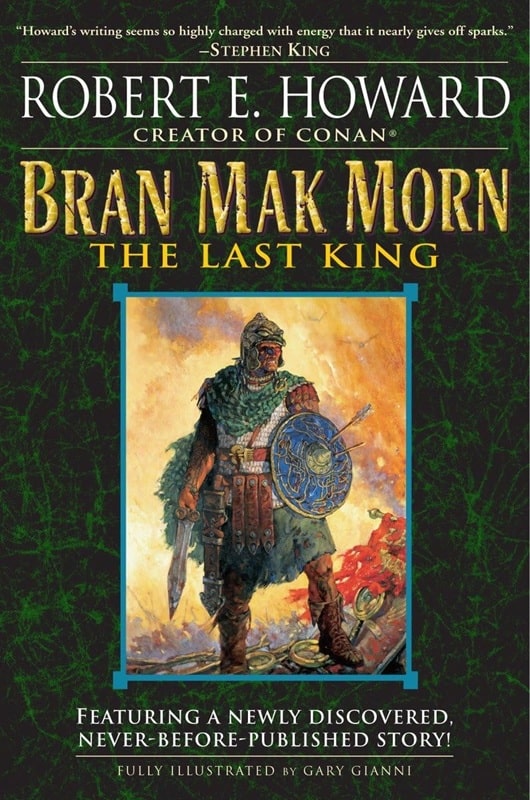
Two more Del Rey Howards: The Savage Tales of Solomon Kane and
Bran Mak Morn: The Last King (July 2004 and June 2005). Covers by Gary Gianni
“I did find out that in a letter Robert E. Howard wrote that Conan’s grandfather had traveled some, told him stories as a kid, and that was of what woke that in him. While he (Howard) never wrote it in a story that helped me see where part of that aspect of Conan came from. But part of that is just his nature too,” Waggoner explained.
The novel, according to Waggoner, will show readers two sides of the barbarian with the story focused on Conan’s life at 17 and 32. It’s a two-part story separated by 15 years, which helped the author show the titular character’s growth over time. This can be seen in his natural cursiotiy as a teenage thief as well as in his expansive knowledge of other languages and cultures later on. Conan’s interactions with religion and the origin of his unique sense of chivalry are also touched on in the book.
“That’s because when I write any kind of tie-in like this I try to imagine them as real people. If I’m trying to write about Conan being real then I have to ask myself why does he do these sorts of things and why are they so important to his character?”
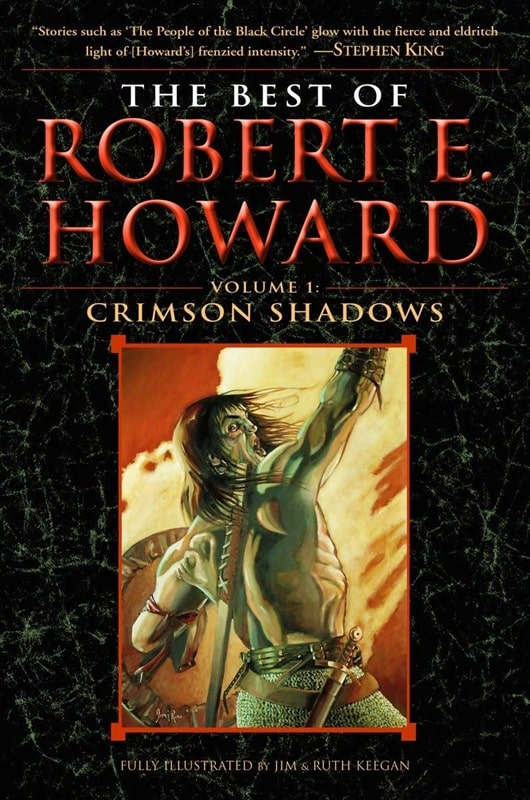
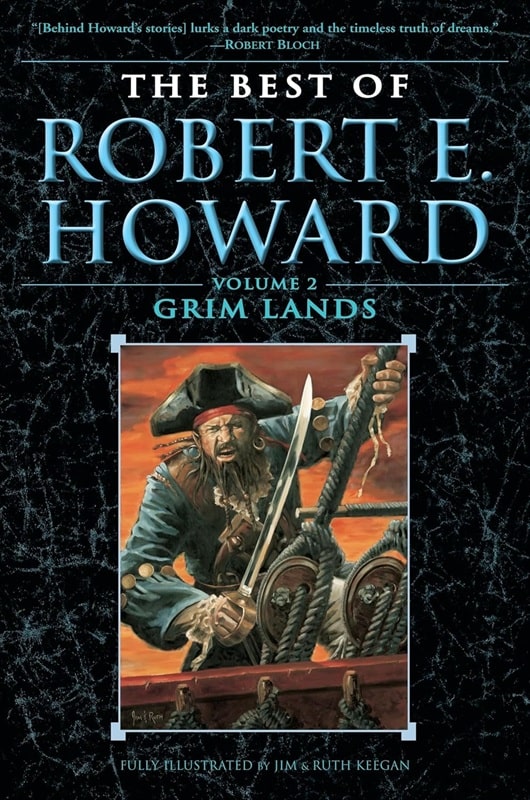
The Best of Robert E. Howard, Volumes 1 & 2: Crimson Shadows and Grim Lands
(Del Rey, August 31, 2009 and December 2007). Covers by Jim Keegan and Ruth Keegan
Its an approach that has worked well in the past and allowed him to touch on a part of Conan a some have missed in the past.
“I think one thing some of the comics and movies miss is that while he (Conan) is dour and grim, that’s not all he is. Howard says in that one description ‘gigantic mirths and gigantic melancholies’. The mirth part you don’t see very much. I tried to put some of that in there. I also tried to show how he had a lot more anger and was quicker to violence at 17 than he was at 32. Over time, he becomes a lot more skilled.”
Of course, given the amount of time left between now and the book’s listed Oct. 27 publication date, things may change and edits might be made. Waggoner admits that some of what he wrote might be edited out though he is hopeful. Midway through the conversation I mention Conan’s connection to Cthulhu and Waggoner’s answer leaves me hopeful too.
“I tried to include some of that too,” he said with a smile.
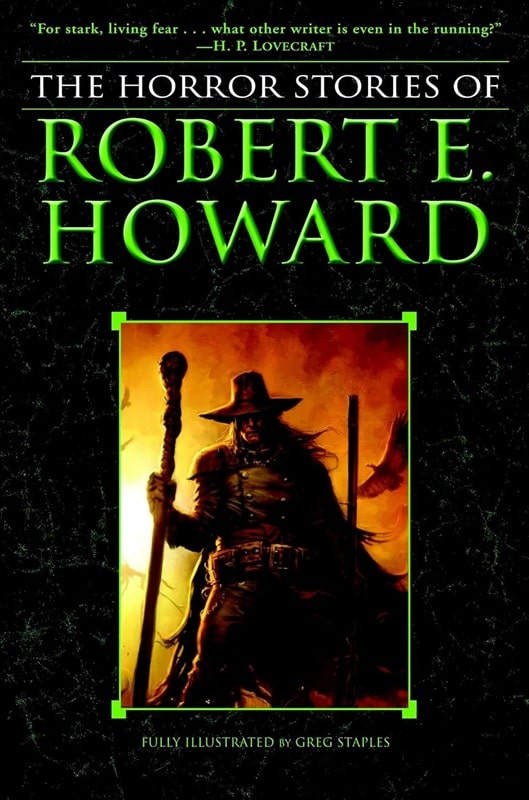
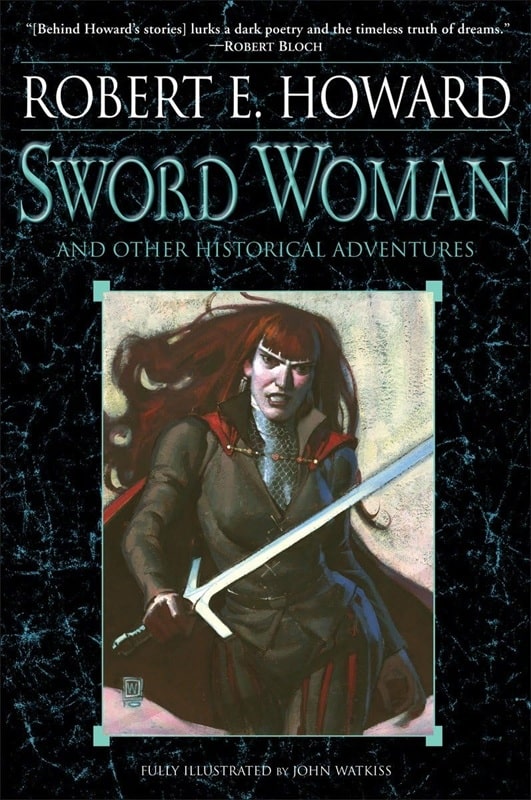
The Horror Stories of Robert E. Howard and Sword Woman (Del Rey,
July 29, 2008 and January 25, 2011). Covers by Greg Staples and John Watkiss
Regardless, its clear a ton of work has gone into making the novel as best as it can be. When Conan: Spawn of the Serpent God does come out, it will be a welcome addition to many bookshelves around the world. And if Titan’s release schedule is anything to go by, the beloved sword-wielding warrior shows no signs of slowing down. Conan, its no exaggeration to say, is thriving.
“I think he’s endured so long because he’s the same sort of character, ultimately, as the lone gunslinger or the private eye. He’s the individual that is true to himself and can be himself in whatever society he’s in,” Waggoner said.
But there is one other ingredient the author feels separates Conan from the pack. One so important it leaves other legacy characters like Sam Spade and The Shadow in the dust.
“With Conan his motive ultimately is adventure. It’s living life and experiencing it absolutely to the fullest. You don’t see that in a lot of warrior type characters. You don’t see that in the lone gunslinger. The private eye is usually depressed. Conan, however, I don’t think we even know what happens to him at the end of his life because eventually he tells his son ’you be king, I’m out of here’ and just goes adventuring all over again,” Waggoner said with a laugh.
Ismail D. Soldan is an author, journalist, and poet. His work has previously appeared in Illustrated Worlds, LatineLit, and The Acentos Review among other publications. A proud explorer of both real and imagined worlds, his most recently published short story can be read in the January 2025 issue of Crimson Quill Quarterly, and his last article for Black Gate was New Adventures for the World’s Favorite Barbarian.

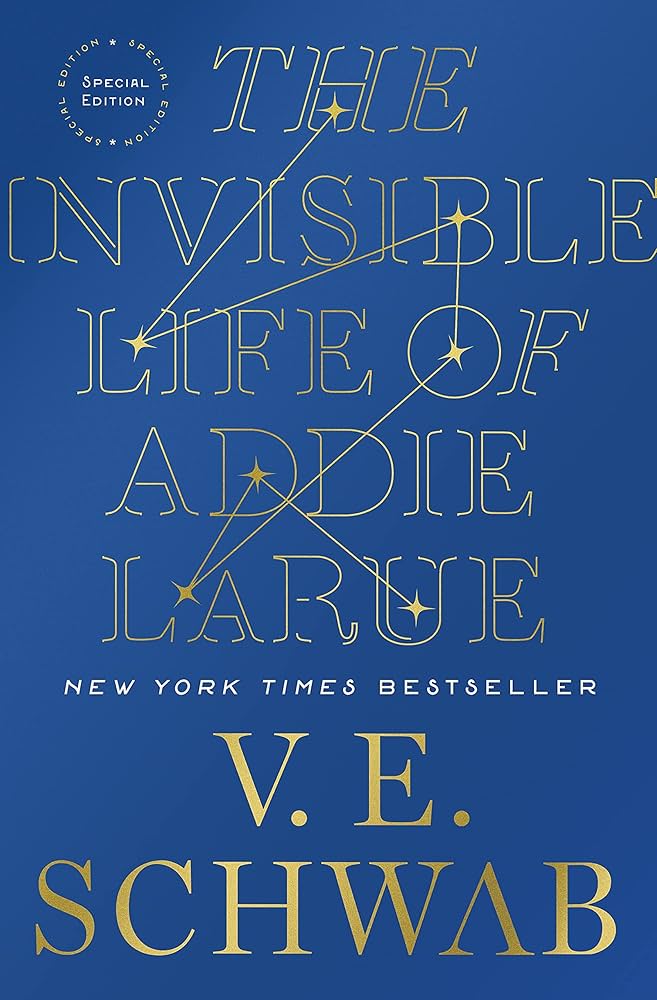
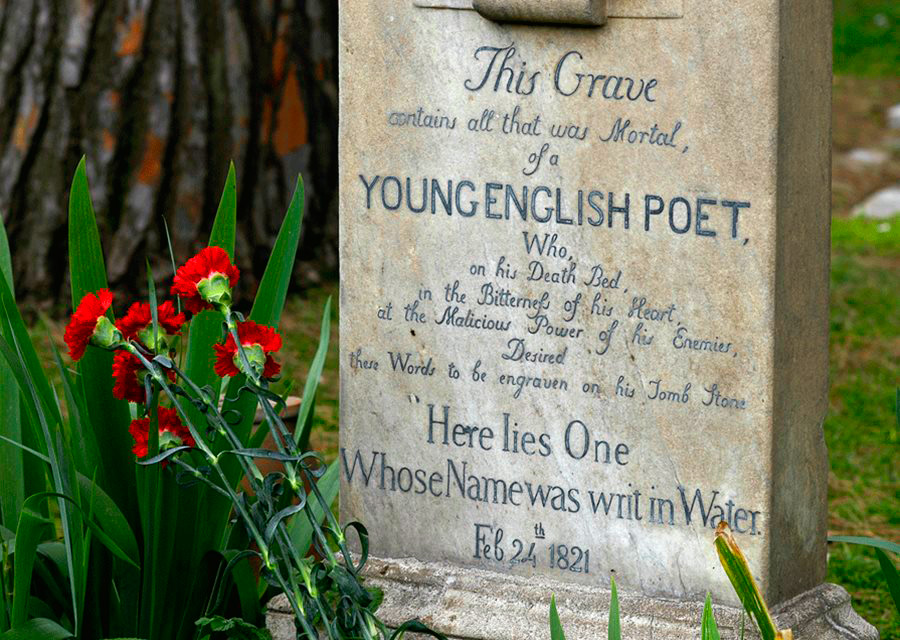

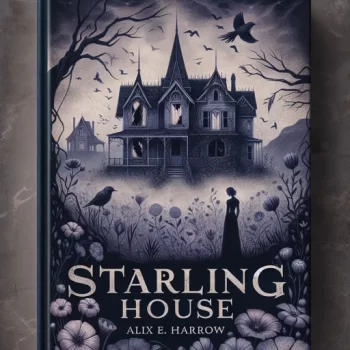

Recent comments